Theros: Beyond Death Limited Ratings
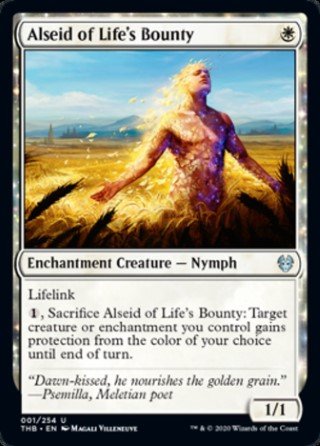
Alseid of Life's Bounty
AI Rating: 3.7Pro Rating: 3.0
This one drop has an ability that keeps it relevant all game long. Early on, it can attack and get in for some damage, and it has lifelink so putting Auras on it feels pretty good! But once it can no longer attack effectively, its ability to give Protection to thinks will be a huge boon. You can use it to help a creature get in lethal, wreak havoc on combat, or save a creature from removal.
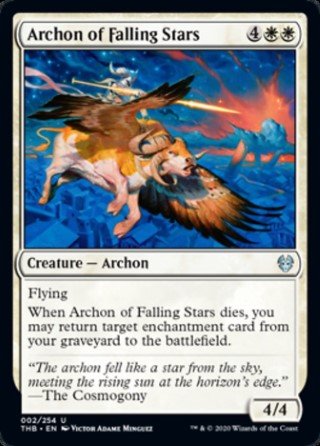
Archon of Falling Stars
AI Rating: 4.1Pro Rating: 3.0
A 6-mana 4/4 flyer isn’t great but putting an Enchantment from your graveyard on the battlefield when it dies Is pretty nice. One thing I really like about that is that it is ANY Enchantment -- several cards in this set focus on Auras, but not the Archon, who is able to bring back any sort of Enchantment -- including Enchantment creatures. When you do that, you’re usually going to be getting a 2-for-1, and those go a long way towards shifting games in your favor.

Archon of Sun's Grace
AI Rating: 5Pro Rating: 5.0
A 4-mana ¾ with flying and Lifelink is already a good. That’s just a lot of value for 4 mana. Those two key words together are quite powerful, because Flying makes the creature hard to block, and lifelink makes it pretty impossible for your opponent to race you, since if this is hitting your opponent, you are creating a 6-point gap between your life total and your opponent’s. Even if it can’t attack, a sizable flying blocker that gains you life is great! But then, of course, it comes with an Absurd Constellation ability – making you a 2/2 every time you play an Enchantment, and oh – by the way, those tokens will have lifelink because the Archon is also a Pegasus lord of course! This set is loaded up with Enchantments, so it isn’t even really necessary to go out of your way to build around this. It is a pretty incredible bomb.

Banishing Light
AI Rating: 4.4Pro Rating: 5.0
This is a premium removal spell whenever we see it. Three mana to deal with any non-land permanent is incredible, especially because it is exiled -- something that really matters in a set with a graveyard matters theme. It is also an Enchantment, which gives this already very powerful cards some additional value in a set with an Enchantment theme. One thing not going for Banishing Light is the fact that this set, in addition to having way more Enchantments than normal, also has way more ways to deal with Enchantments than is the norm, meaning your opponent can get the permanent back from this more often than you might think. But still, most of the time, this will at least take care of a problem permanent for a few turns, and that will often be enough.

The Birth of Meletis
AI Rating: 3.4Pro Rating: 2.5
This might seem like it does 3 kind of minor things -- but I think it is a pretty reasonable inclusion in White decks in this format. Searching up a Plains gurantees you will hit your 3rd land drop, a 0/4 defender is unexciting, but it does add something to the board, and 2 life is unexciting too. But, if you look at this with all the parts together, it is basically Wall of Omens that gains you 2 life, for the same mana cost, and that’s something I want to play, especially in less aggressive White decks.
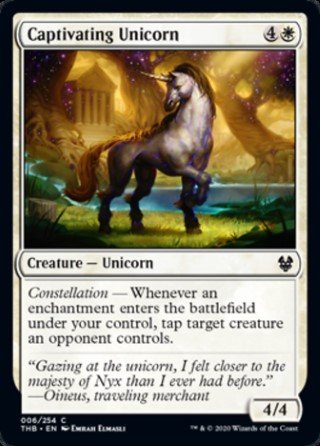
Captivating Unicorn
AI Rating: 1.4Pro Rating: 1.5
The Constellation Trigger here is alright, and the stats of the creature are passable. You’ll play this at the top of your curve in some aggressive decks.

Commanding Presence
AI Rating: 4Pro Rating: 3.0
This set has lots of good Auras in it, and this is one of them. This is expensive, but the stats boost it offers is big enough that it completely alters your game plan, and once you start getting tokens out of it you’ll be far ahead of your opponent.
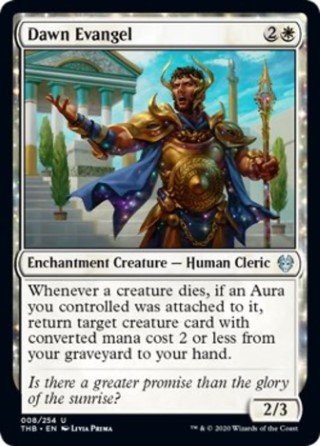
Dawn Evangel
AI Rating: 3.2Pro Rating: 2.5
The Evangel also helps you avoid the dreaded 2-for-1, since if one of your creatures with an Aura gets killed, you get something back that puts you and your opponent at parity in terms of cards. One kind of weird thing to note about this card, is it doesn’t matter whose creature with an Aura dies, either way, you get the opportunity to put a small creature back into your hand. All that said, I feel like there is a considerable chunk of the time where this is just a 3-mana 2/3.

Daxos, Blessed by the Sun
AI Rating: 3.8Pro Rating: 3.0
On his own, with no help, he is a 2-mana 2/2 with a nice lifegain ability. With just a few more White symbols lying around on your board, he becomes a fairly reasonable blocker who can also do some attacking if he needs to. Meanwhile, he is also gaining you a bit of life here and there. That’s all nice value on a two-drop, even if he does cost double White.
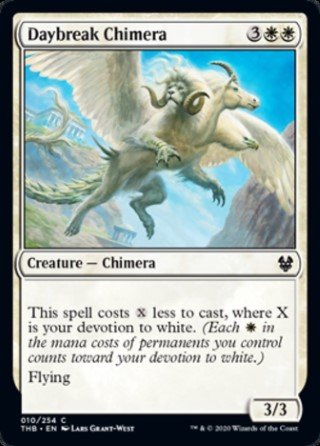
Daybreak Chimera
AI Rating: 3.1Pro Rating: 3.0
This isn’t great if you have 0 devotion to White, but all you need is one devotion for this to become a 4-mana 3/3 Flyer, which is a great deal in Limited, and sometimes it will only cost three!

Dreadful Apathy
AI Rating: 3.7Pro Rating: 3.5
This is a nice removal spell, and unlike most Pacifism-type effects, this one can let you permanently get rid of the creature, which is worth doing any time you have the mana lying around, since if your opponent finds a way to get rid of the Aura, or if the creature has a static ability, you’re going to be in trouble. This is premium removal.
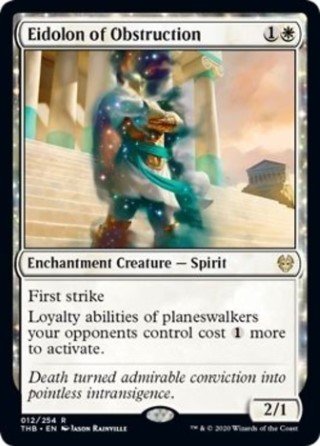
Eidolon of Obstruction
AI Rating: 4.6Pro Rating: 3.0
So, the Planeswalker part is not going to come up very much in Limited, but this has a nice baseline as a two mana 2/1 with First Strike who happens to be an Enchantment.
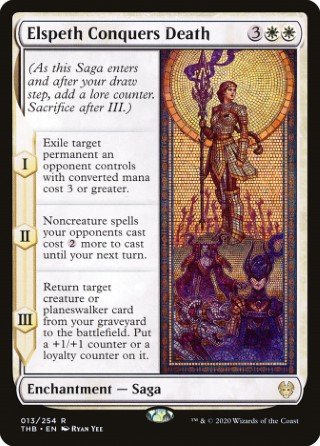
Elspeth Conquers Death
AI Rating: 5Pro Rating: 5.0
This saga gives you a crazy amount of value. Right away it will kill a big creature, then Chapter II will make your opponents’ life more difficult, and Chapter III lets you reanimate something and add a counter to it. This end sup being a very powerful 2-for-1 by the time you cast it in just about every game, and if all three Chapters go off, it is unlikely you lose.
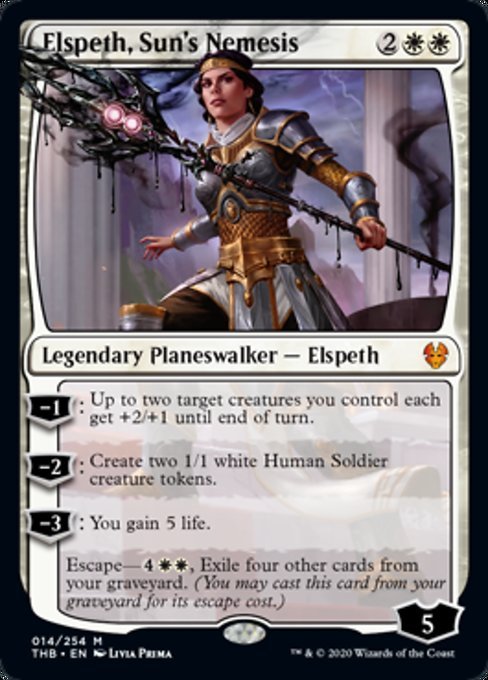
Elspeth, Sun's Nemesis
AI Rating: 4.9Pro Rating: 4.5
I think the design here is really cool. She is a planeswalker with only minus abilities, and they don’t do the most impressive of things, but the fact that she can just keep coming back, if you can pay for her Escape effect, she is going to make things kind of silly. So yeah, her abilities -- pumping a coule of creatures for a turn can be nice, and push in some extra damage, but her -2 is probably the best, since it allows her to add to the board. Her -3 is kind of bad, but sometimes you’ll need life, and she can do that too! I think most of the time, you’ll use her -2 twice, and then her -1 to make them bigger so they can attack. And then, later in the game she can come back and do it all over again, potentially multiple times!

Favored of Iroas
AI Rating: 3.2Pro Rating: 2.5
This can hit hard on turns when you get the Constellation going, and putting an Aura on him in particular feels pretty great.

Flicker of Fate
AI Rating: 1.4Pro Rating: 1.0
Like most similar cards we see, Flicker of Fate is highly situational, and only really worth running in a very narrow number of decks – like those with tons of ETB triggers.

Glory Bearers
AI Rating: 1.4Pro Rating: 1.5
This has kind of okay stats and a kind of okay ability. Pumping toughness on attacks isn’t a huge deal, but it makes a difference sometimes.

Heliod, Sun-Crowned
AI Rating: 4.9Pro Rating: 4.5
So, Heliod helps you both gain life, and is a nice payoff for doing it. Lifelink is already a great keyword ability because of the way that it drastically alters races, and getting +1/+1 counters when you gain the life makes that even more true! Obviously Heliod gets even better when you have other ways to gain life, but he can be an engine all on his own sometimes. Like all the Gods being huge and indestructible when loyalty gets high enough is also really nice.

Heliod's Intervention
AI Rating: 4.7Pro Rating: 4.0
This set has so many Enchantments that Heliod’s Intervention is actually a really good card, and not sideboard material. Getting a 2-for-1 with this is way easier than you might think, and sometimes you can do better than that!
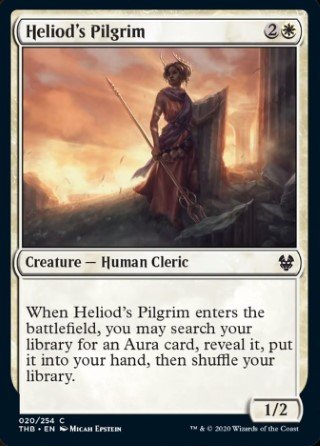
Heliod's Pilgrim
AI Rating: 3.2Pro Rating: 3.0
This set has so many Enchantments that Heliod’s Pilgrim is a nice card in virtually every White deck, as its ETB reads “Draw your best Aura.” This can let you grab removal, or powerful offensive auras, either way, you’re getting a very meaningful card out of the trigger.
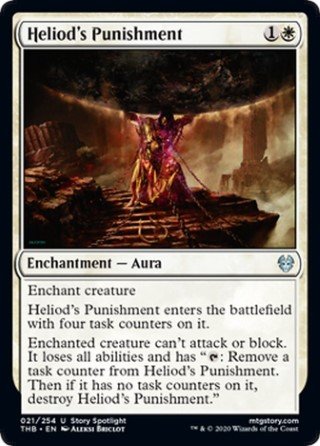
Heliod's Punishment
AI Rating: 3.1Pro Rating: 3.5
This is a very efficient removal spell, capable of completely shutting down a creature – at least for a few turns. Obviously it would be better if your opponent couldn’t eventually get rid of it, but it takes them time to remove those task counters, and generally a creature being out of commission for 3+ turns will be worth the mana here.
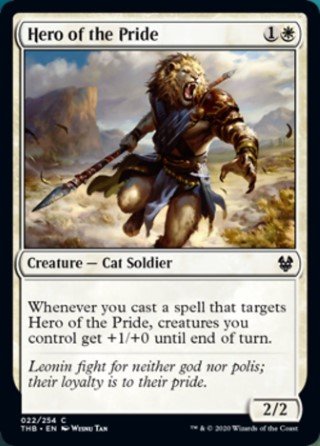
Hero of the Pride
AI Rating: 2.4Pro Rating: 2.0
A bear with a decent upside.
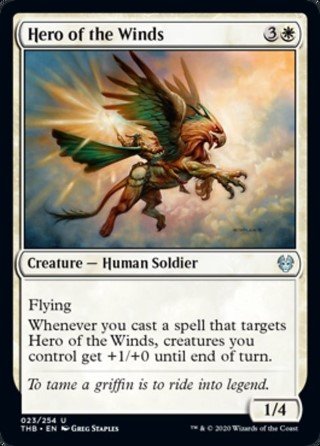
Hero of the Winds
AI Rating: 2.1Pro Rating: 2.0
So, a 4-mana ¼ with flying is not a playable card most of the time, but this comes with significant upside -- however, for that upside to really be obtained, you need two things: a deck that can go wide, and a deck with lots of cards that target your creatures -- this, of course, includes Auras. And while those things will happen in enough White decks, I don’t think the set up or the payoff here is so good that you take it all that early.
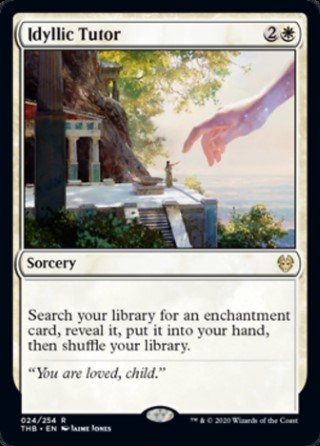
Idyllic Tutor
AI Rating: 4.6Pro Rating: 0.5
Typically, tutors that are this expensive and restrictive aren’t very good, and that largely continues to be the case here. If you have a bomb Enchantment you might consider it, but even then I’m not a huge fan.

Indomitable Will
AI Rating: 2.2Pro Rating: 1.5
This is basically a combat trick that sticks around, and if you can use it to kill an opponent’s creature and keep yours alive, you are out of 2-for-1 territory. Now, it is still risky -- your opponent can kill your creature in response and then you’re the one getting 2-for-1’d -- but if you play this wisely, it seems like it is a reasonable inclusion in a creature-based deck.
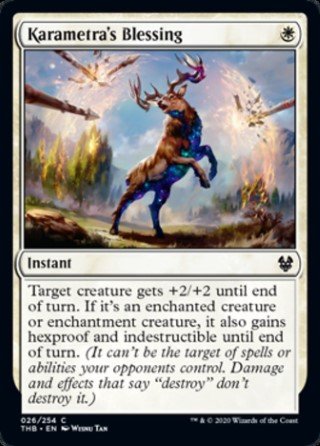
Karametra's Blessing
AI Rating: 2.1Pro Rating: 1.5
This is a decent trick with nice Enchantment upside – it IS still a trick though, and you’ll only play it in the most aggressive of decks.

Lagonna-Band Storyteller
AI Rating: 3.2Pro Rating: 2.5
This ETB trigger is pretty nice! There are lots of good Enchantments in this set, including Sagas which throw themselves in the graveyard, so getting something back with the Storyteller isn’t that hard to set up. People often overrate how good putting something on top of your library is – keep in mind that it is just card selection, and not card advantage. That doesn’t make the Storyteller bad, just not as good as some might think.
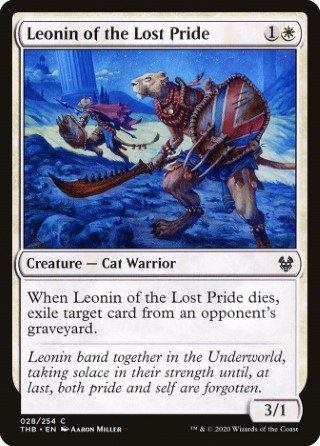
Leonin of the Lost Pride
AI Rating: 2Pro Rating: 2.0
A two mana 3/1 is already decent enough, and the exile clause here actually comes up in Limited, since there are so many cards with Escape.

Nyxborn Courser
AI Rating: 1.7Pro Rating: 1.0
This is a vanilla creature with reasonable stats and the Enchantment type, as well as two White mana its cost for Devotion. You’ll play it sometimes when you need one or all of those things.
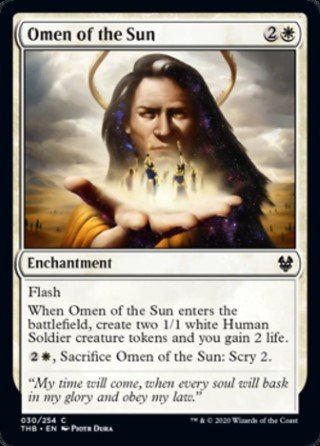
Omen of the Sun
AI Rating: 3.5Pro Rating: 2.0
If we just pretended like Omen of the Sun were an Instant – that created two 1/1 soldiers and gained you 2 life, it would be in the lower range of playable – probably something you cut more often than not. The nice thing about making the tokens at Instant speed is that sometimes you can ambush an opponent’s 3/1 or something, at which point you’re really coming out ahead. But obviously, Omen of the Sun has more going on than just that – since it can be cashed in for Scry later in the game, and it is also an Enchantment in a set where that’s important.

Phalanx Tactics
AI Rating: 3Pro Rating: 2.0
This is the kind of trick that can really produce a blowout when things line up correctly! Pumping multiple creatures with one trick can be really strong, and this is especially good if you’re going fairly wide.
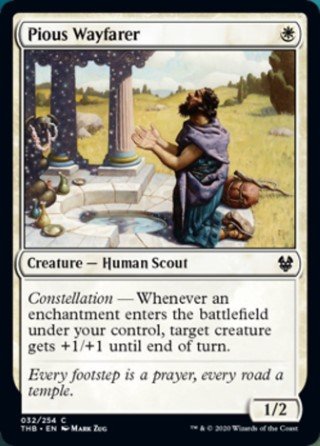
Pious Wayfarer
AI Rating: 2.4Pro Rating: 2.5
This is a pretty nice one-drop. In the early going, it can pump itself with its Constellation trigger, but in the later part of the game he can start pumping more meaningful creatures – the kind that can attack as a result of the stats boost they receive. That helps keep him relevant all game long.

Reverent Hoplite
AI Rating: 3.3Pro Rating: 2.5
So the fail case here is a 5-mana ½ that makes a 1/1. So, what does your devotion need to be for this to stop being unplayable? 2 devotion still won’t feel so good, but it is probably passable. I think at 3, where you are getting ⅘ worth of power spread across 4 bodies for 5 mana, you feel like you’re doing alright and obviously the ceiling here can go even higher. It does bother me that the fail case here is so bad -- the best Devotion cards are the ones where the fail case is semi-reasonable, but that isn’t what we have here. Still, if your deck has a decent amount of White in it, this will be better than the fail case most of the time, especially because you play it so late.

Revoke Existence
AI Rating: 2.4Pro Rating: 2.5
So, your first instinct might be to think that this is just a sideboard card -- but in this set, where tons of creatures also happen to be enchantments, and there are just more Enchantments than usual in most sets, this is a reasonable card to play one of in your deck.
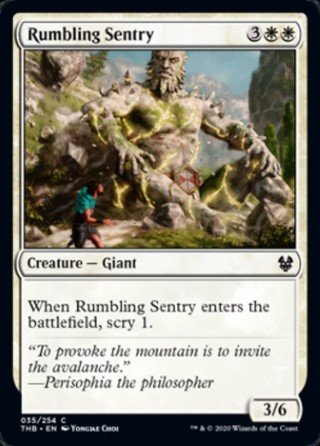
Rumbling Sentry
AI Rating: 0.6Pro Rating: 1.5
This has good defensive stats, you’ll play it in more controlling decks.

Sentinel's Eyes
AI Rating: 2.4Pro Rating: 2.5
This Aura gets around the classic problem that many of them have – the danger of a 2-for-1. With Escape, you can avoid that ever being a real problem, and enjoy the benefits of a pretty efficient stats boost on your creatures.
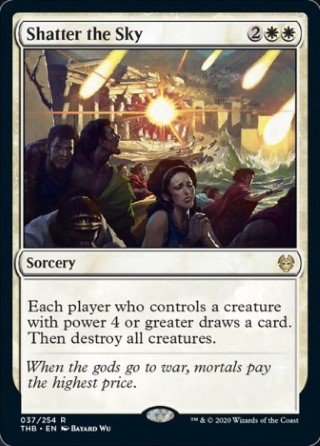
Shatter the Sky
AI Rating: 5Pro Rating: 4.5
This is a pretty nice board sweeper, though it is a little frustrating that your opponent gets to draw a card off of it on a pretty regular basis. Sweepers often already have the problem of allowing the opponent to rebuild before you can, and now they will have even more fuel to do so. Still, you also get to draw the card off of this sometimes, and the effect it has is completely game-altering.
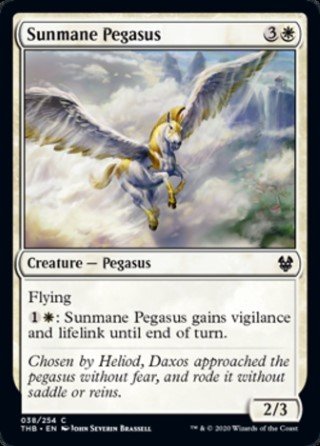
Sunmane Pegasus
AI Rating: 2.5Pro Rating: 3.0
This card really overperforms. It might have some underwhelming stats to begin with, but the ability to gain Vigilance and Lifelink in the mid-to-late game turns out to be pretty good, as it makes it hard for your opponent to race you, and you can even keep it back to block!

Taranika, Akroan Veteran
AI Rating: 5Pro Rating: 3.5
She has good stats and the ability to make one of your other creatures into a really problematic attacker for your opponent. Relatively early on, she does get to the point where she probably dies on the attack, but she generally will give you enough value by just sending an indestructible creature, that that isn’t too shabby.

Transcendent Envoy
AI Rating: 2.8Pro Rating: 2.5
There are lots of playable Auras in this set, and the Envoy makes them cheaper, and also happens to be a really good place to stick those Auras thanks to Flying.
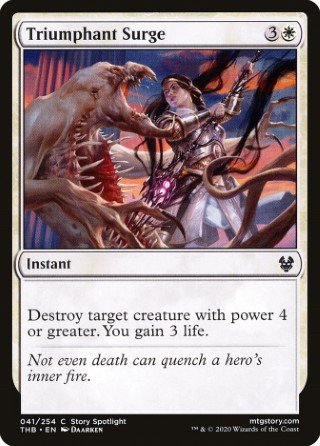
Triumphant Surge
AI Rating: 1.9Pro Rating: 1.5
This kind of “Kill a big thing” removal spell is always fine, but generally not more than that.
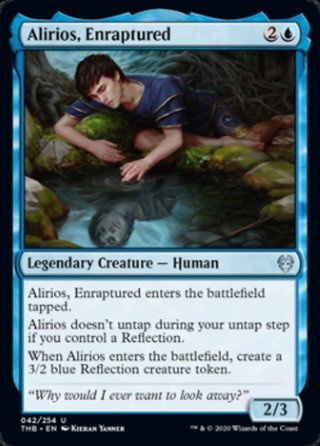
Alirios, Enraptured
AI Rating: 4.1Pro Rating: 4.0
This gives you a great rate – you get 5/5 worth of stats for three mana! And sure, generally only one of them is going to be untapped, but when Alirios dies he leaves behind significant value. This is one of the best ETB abilities to abuse in this entire set too, so if you have ways to do that, considering utilizing them here.
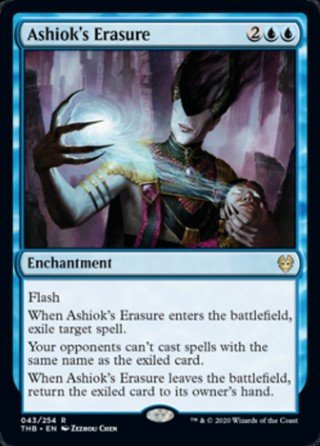
Ashiok's Erasure
AI Rating: 4.5Pro Rating: 0.0
In Limited, this is going to amount to being a 4-mana counter spell with the signifcant downside of giving the opponent back their card, should they ever get rid of the Enchantment. Don’t play this.

Brine Giant
AI Rating: 1.8Pro Rating: 1.5
This is basically affinity for Enchantments. I think you need to consistently only be paying 5 for this for it to be worth it, and even 5 isn’t anything impressive. Lower than that and it starts to be a little more passable.
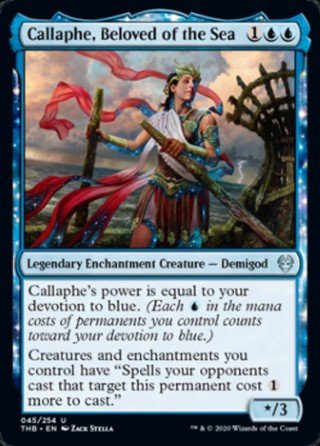
Callaphe, Beloved of the Sea
AI Rating: 4Pro Rating: 2.5
At worst this is a 3-mana ⅔ that makes your opponent’s removal spells cost more. Making your opponent pay more for removal means your opponent will have a much harder time finding a way to trade up with their removal spells, and obviously means it will take them longer to cast them. Then, this will frequently be at least a 3-mana 3/3 with that ability, and then you’re kind of in business -- especially because it can get even bigger than that! This basically comes down to being an efficient creature with an impactful, albeit not amazing, static ability.

Chain to Memory
AI Rating: 0.4Pro Rating: 1.0
Adding Scry 2 to this effect does make it more appealing than some variants of this we’ve seen before, but overall these types of power-reduction effects are too situational, and difficult to get a full card of value out of.
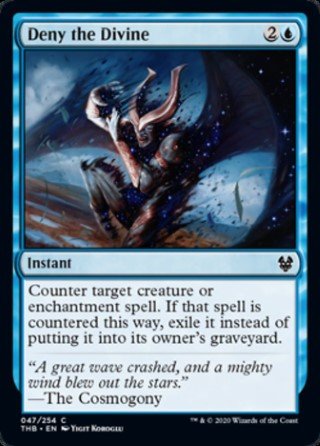
Deny the Divine
AI Rating: 1.6Pro Rating: 2.5
This is quality counter-magic in this format. It is capable of countering the vast majority of spells that you’ll run into, it does it relatively efficiently, and it even exiles the card cutting down on Escape shenanigans.
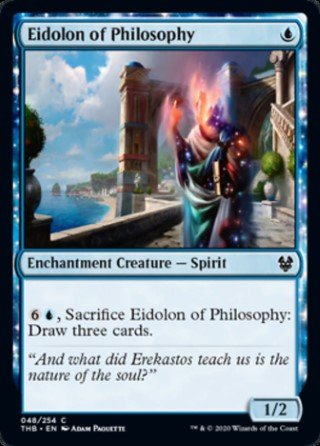
Eidolon of Philosophy
AI Rating: 0.9Pro Rating: 1.5
A one mana ½ just isn’t worth the card most of the time, but having the ability to draw 3 cards in the late game is kind of nice It is also an Enchantment, which certainly will matter in this format. Most decks won’t be interested in this, but if you have a sweet control deck, playing one of those won’t be too bad.
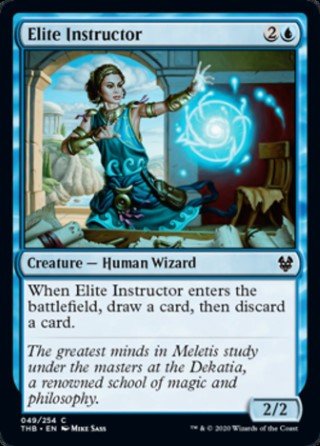
Elite Instructor
AI Rating: 0.9Pro Rating: 1.5
This has bad stats but a decent ETB ability. Looting does mean that it does something kind of relevant all game long, although it isn’t the most impressive thing.
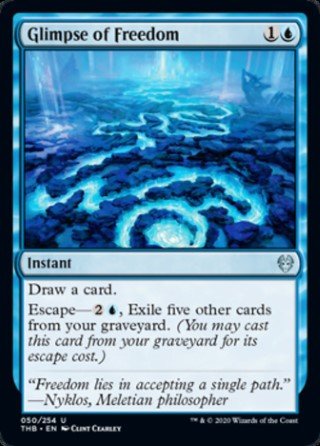
Glimpse of Freedom
AI Rating: 1.3Pro Rating: 1.5
This isn’t the most efficient card-draw spell ever – for 5 mana you end up drawing only two cards. It tries to make up for that by having Escape, but in a typical game you’re not going to have the time or resources to do it more than once anyway.

Ichthyomorphosis
AI Rating: 2Pro Rating: 2.5
Blue always get a solid, but unexciting, removal spell that transforms a creature into something else. The downside with all of them is that the creature can still do stuff, even if it is shrunk. At best, this tends to mean the creature can still chump block, and at worst it means the creature can still be sizable thanks to Auras, +1/+1 counters, and Equipment.

Kiora Bests the Sea God
AI Rating: 5Pro Rating: 5.0
This is an unbeatable bomb. It gives you a huge hexproof creature up front, which will usually be enough to keep you alive long enough to get to the next two chapters. Chapter II makes it so your whole board can probably get in on the next turn, and then Chapter III steals your opponents’ best permanent. So, this is basically a 3-for-1 that tends to do 10+ damage to your opponent.
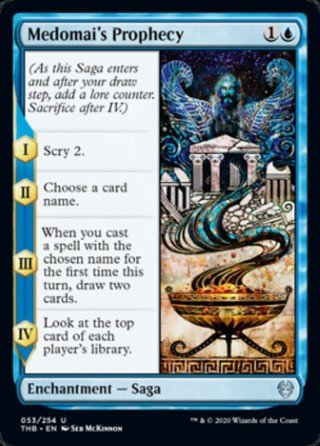
Medomai's Prophecy
AI Rating: 4.2Pro Rating: 2.5
This gives you a bunch of small effects, but taken together they make for a reasonable card. The one thing that bothers me about is that sometimes you just can’t cast what you named with Chapter II, because the state of the game demands you do something else, but I think you draw 2 off of it often enough that it turns out to be a solid card.

Memory Drain
AI Rating: 0.5Pro Rating: 0.5
This counterspell costs way too much mana, and adding Scry doesn’t really help that.
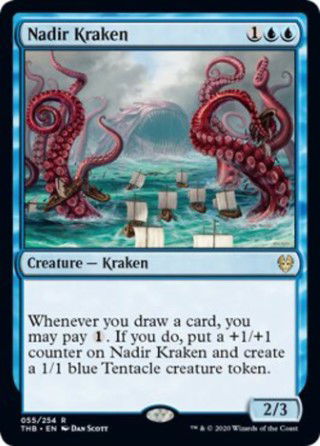
Nadir Kraken
AI Rating: 5Pro Rating: 4.5
If you’re allowed to untap with this you end up with a ¾ and a 1/1, which is excellent for a 4-mana investment, and it just starts to snowball from there, getting massive and making more friends. Obviously if you have additional ways to draw cards it gets to be even sillier. This is a bomb -- that isn’t something you can say about a lot of three drops, but you can say it here. It can take over the game no matter when you play it. The one downside it has is that it is pretty vulnerable initially, as a ⅔, but it can grow big enough to avoid a lot of removal, and even if you only get two or three turns with this, you’re doing a great job, and if you get more than that you probably just win.
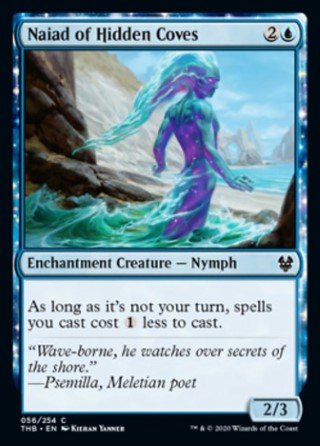
Naiad of Hidden Coves
AI Rating: 1.9Pro Rating: 2.5
Reducing the cost of your instants and cards with Flash is pretty nice – as it will enable you to trigger your other payoffs more easily, and cast more powerful spells sooner. The fact that this also comes with a semi-reasonable body is nice too – they could easily have printed this as a 2/2 and it still would have been decent, so I’m pretty happy with 2/3 here.
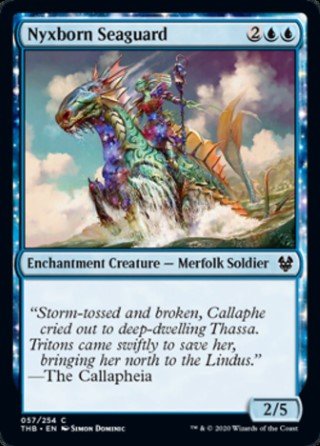
Nyxborn Seaguard
AI Rating: 0.2Pro Rating: 1.5
This is a vanilla creature with the Enchantment type and it also contributes to your devotion. The stats here aren’t too shabby, so you’ll play it sometimes.
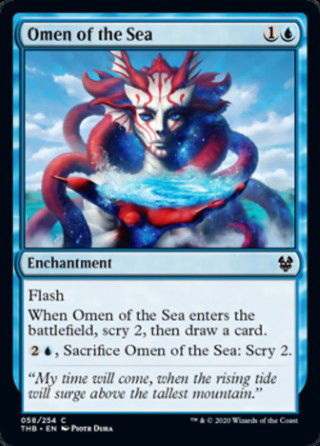
Omen of the Sea
AI Rating: 3.1Pro Rating: 2.5
Two mana to Scry 2 and draw a card at instant speed is already kind of a reasonable thing -- compare it to Anticipate. Here, the fact that you can use it to Scry later on in the game, and the fact that it will be right at home in a few different decks in this format -- both those interested in Enchantments, and those interested in doing stuff on the opponent’s turn -- is enough for this to be a solid playable.
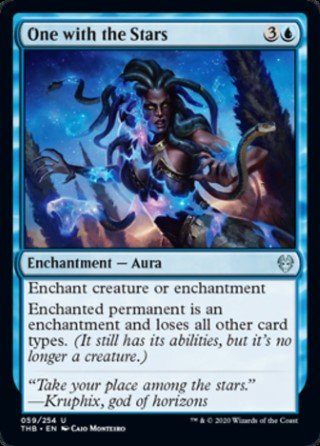
One with the Stars
AI Rating: 2.7Pro Rating: 2.5
This is a pretty clunky removal spell, but it is nice that it can shut down most creatures – for the most part. Abilities will still stick around, but it at least makes a creature unable to attack or block, and those are the key things in most Limited games anyway.
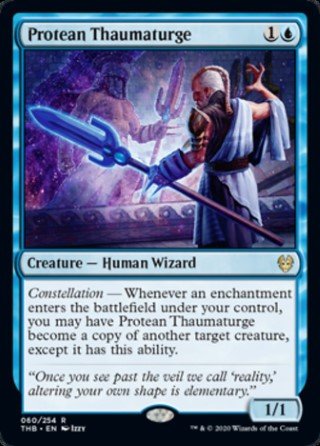
Protean Thaumaturge
AI Rating: 4.6Pro Rating: 3.0
This is incredibly vulnerable at first, but the Constellation ability to turn into whatever the best creature on the battlefield is pretty darn good. It either means you have an additional copy of your best creature, or a creature that can at least compete with your opponents’ best creature.

Riptide Turtle
AI Rating: 0.9Pro Rating: 1.0
This has Flash, which matters for the UR deck in this format, and it had okay defensive stats, but you still usually won’t play it
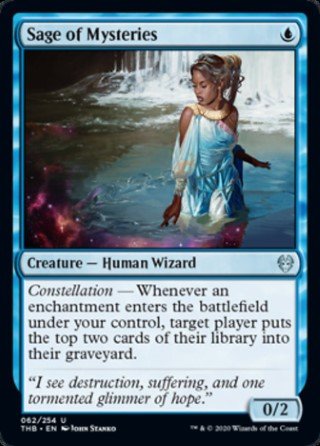
Sage of Mysteries
AI Rating: 0.8Pro Rating: 1.0
Mill isn’t really a strategy in this format, the only cards that do it are at Uncommon or higher, so this is a pretty big dud most of the time. You need a critical mass of mill for it to be a real thing, and this format doesn’t have it.
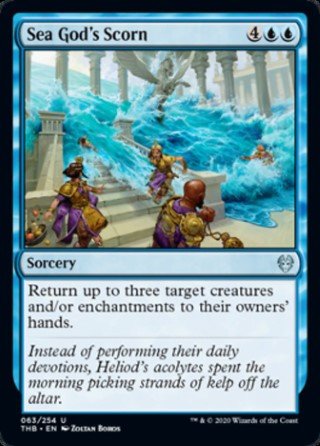
Sea God's Scorn
AI Rating: 1.6Pro Rating: 1.5
This kind of card always seems to disappoint. Don’t get me wrong, what it does is pretty powerful – it can completely reshape the board, and it will be especially nice to bounce things that cost more than 6 mana total, so you’re coming out ahead mana-wise. The problem is, it is pretty impossible to come out ahead card-wise. Sure, your opponent has to recast everything, but if you can’t win the game quickly after casting the Scorn, you’re in trouble. The other problem a card like this always has, is, most Blue decks probably aren’t that interested in an effect like this. This will mostly only be good in more aggressive decks, who can get the opening they want after casting this. Problem is, it costs 6 mana, and most aggressive decks don’t really want to go there. In a mid-rangey or control deck, it is less appealing, since setting up a situation where it wins you the game will be a little more challenging. Also worth noting that you can bounce your own stuff with this, and sometimes that’s the right thing to do.

Shimmerwing Chimera
AI Rating: 4.2Pro Rating: 3.5
A 4-mana 3/2 with Flying is a good starting point, and adding the ability to bounce your stuff is nice. Now, it is important to note that it says “up to one” which means you don’t have to bounce any Enchantments if you don’t want to, and that’s good, because it means that the upkeep ability of the Chimera is only ever going to be upside, and upside on a 4-mana 3/2 Flyer is pretty nice. Now, there will be plenty of times where this is nothing more than a 3/2 Flyer, but you can combine this with some other things to be pretty nasty – this includes the Omen cycle, as well as Sagas, Constellation, and Enchantment creatures with ETB abilities.

Shoal Kraken
AI Rating: 2.1Pro Rating: 2.0
I like looting a fair bit – and it gets some extra value in this set because of the Escape mechanic. This has passable stats too, so you’ll play it in some of the grindier decks.

Sleep of the Dead
AI Rating: 0.4Pro Rating: 1.5
So, temporary tap effects like this are often not super impressive, especially at Sorcery speed! But this only costs a single mana to do it, and it comes with Escape. Sometimes you’ll have enough fuel in your graveyard to cast this 2-3 times, and if you do, it usually means you did lethal. Still, it really only tends to work out in more aggressive decks, and that is a pretty big limitation.
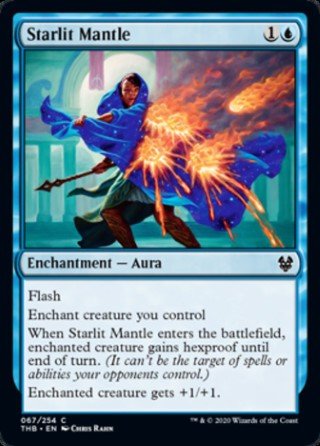
Starlit Mantle
AI Rating: 1.7Pro Rating: 2.0
The flexibility of this to feel like a combat trick that sticks around OR a counterspell against removal is pretty nice, especially in a set loaded with Enchantment payoffs.
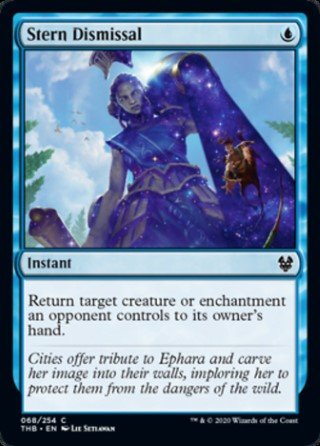
Stern Dismissal
AI Rating: 1.2Pro Rating: 2.5
This bounces things really efficiently, allowing you to come out ahead in terms of tempo virtually all the time. Leaving up the mana for it is pretty easy too, so it is more likely to be used in a blow-out type situation – like in response to a trick or an Aura.

Stinging Lionfish
AI Rating: 3.4Pro Rating: 2.0
Tapping down an opponent’s creature isn’t terrible, as it can both allow you to avoid an attack from your opponent’s best creature, and allow you to have better attacks on your turn. That said, the payoff here isn’t ultra impressive. UR is definitely going to be interested in having a bunch of Instants and cards with Flash, but I don’t think this will be one of the cards you really desperately want for that deck to work -- but it will be a solid roleplayer.
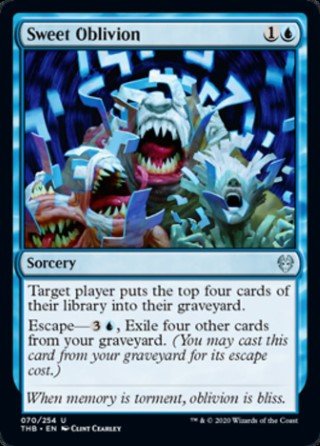
Sweet Oblivion
AI Rating: -0Pro Rating: 0.5
You can use this to mill yourself -- something that might be worth doing in a deck with lots of graveyard synergy -- or you can mill your opponent, something that might be worth doing in a control deck that plans on winning hte game by milling the opponent. Mill decks don’t always come together in formats, but it is nice that this particular mill card can be repeatedly cast from the graveyard. In other words, if you are really good at milling yourself, and you can provide the cards to fuel Escape, this one card could be enough to win you the game by milling your opponent. If this were at Common, it would kind of be a nightmare, since Mill decks would be pretty easy to draft, since getting 2 or 3 of these would be no problem -- at uncommon, getting multiples of this might be tricky.

Thassa, Deep-Dwelling
AI Rating: 4.8Pro Rating: 4.0
Her ability to blink creatures every turn isn’t bad -- it can allow you to abuse ETB abilities, and also gives one of your creatures pseudo-vigilance every turn. It also means that she will usually have some impact on the board right away, even if only effectively untapping a creature. Additionally, every color has Enchantment-based removal spells at lower rarities, and Thassa can make those fall off of your creatures. On top of that, if you have a ton of mana lying around, she can tap stuff -- which is a powerful effect -- but it does ask for a lot of mana, though it is a nice mana sink. Then, of course, if your devotion is high enough she becomes a huge, indestructible creature. So, where does that leave us? Well, she needs to be built around a little, and her activated ability is not exactly priced to move, and I think both of those things keep her from being a straight up bomb – but she has the real potential to be a value engine.

Thassa's Intervention
AI Rating: 4.7Pro Rating: 2.5
Neither mode here is stellar, but having them both on a single card is nice. Basically if you have mana up for this when your opponent plays something you can counter, that’s probably the mode you choose. But, if your opponent doesn’t cast something you can counter and you’ve left mana up, you can at least use it to draw a couple of cards.
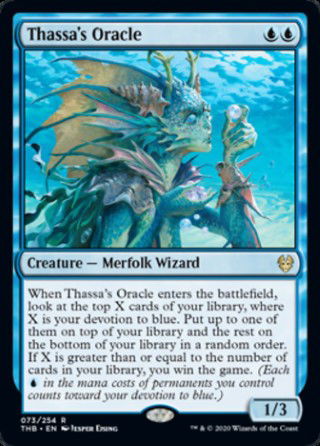
Thassa's Oracle
AI Rating: 4.4Pro Rating: 2.5
On its own, the Oracle is a two mana 1/3 that gives you some card selection. Oftentimes it will give you even better card selection, when your devotion is higher. Winning with this in Limited is unlikely, but the reasonable stats and ability to help you find what you need makes it a fine card.
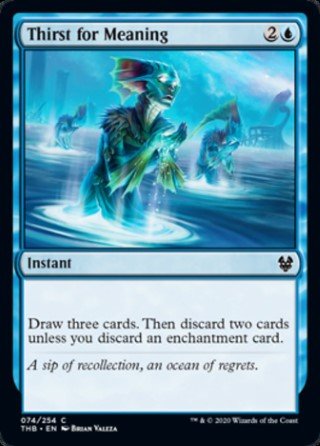
Thirst for Meaning
AI Rating: 1.8Pro Rating: 2.5
This is a decent draw spell. Sometimes giving up an Enchantment will be worth it, but don’t just do it automatically. Sometimes giving up a couple of lands will just be better.
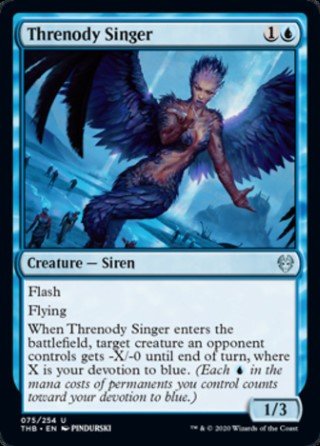
Threnody Singer
AI Rating: 3.1Pro Rating: 3.0
This can often lower an attacking creature’s power by a significant amount, and its arrival on the board increases the chances you will have of setting up a block that kills whatever it is you decided to weaken. It really isn’t that hard to find a way to make Threnody Singer and the rest of your board kill a creature, and even when you don’t, you are getting a reasonable creature.
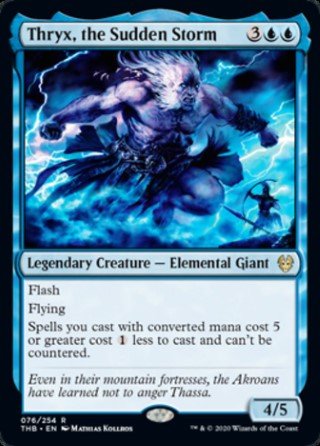
Thryx, the Sudden Storm
AI Rating: 5Pro Rating: 4.5
A 5-mana 4/5 flyer is probably already really good. When you have a creature this big who has flash, it isn’t hard to get a 2-for-1 out of it, since it can flash in and ambush much smaller creatures. Then, you have a huge efficient flyer who can get the job done in the air. He also makes your expensive spells cheaper, and makes them encounterable – the uncounterable part won’t come up a ton in Limited, and reducing the cost of spells won’t come up a bunch either, so don’t expect that part to matter more than a time or two per draft. Of course, that time or two is pretty great when attached to a creature this impressive.
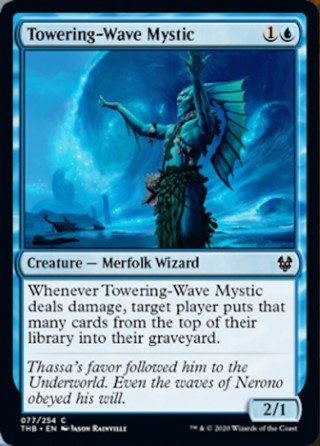
Towering-Wave Mystic
AI Rating: 0.7Pro Rating: 2.0
This can help you mill your opponent if that’s what you’re interested in doing, but it can also mill you -- milling yourself will probably be more useful most of the time, as this format has lots of graveyard action, as we’ve already said. It is still a creature with sub-par vanilla stats, but I think the fact that it can help stock your graveyard and/or mill your opponent is enough for it to be a card you feel decent about as the 22nd or 23rd card in your deck.
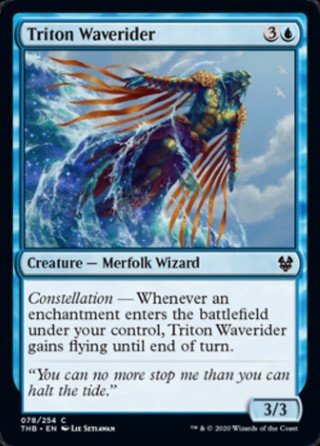
Triton Waverider
AI Rating: 0.9Pro Rating: 2.0
It is tempting to look at this as a 4-mana 3/3 Flyer, and it isn’t that hard to trigger Constellation, but the key is triggering it consistently, and at a time when a 3/3 Flyer matters, and it seems like that doesn’t happen nearly as often as you’d hope.
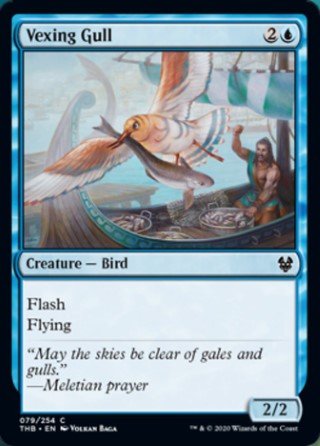
Vexing Gull
AI Rating: 2.3Pro Rating: 2.5
Three mana for a 2/2 flyer used to sort of be the quintessential common for Blue, and these days, as creatures continue to get stronger, that stat-line isn’t quite as impressive – but by adding Flash to the mix here, you have a pretty nice card. Flash creatures can of course be used to come into play and ambush an attacker, but a 2/2 isn’t going to be doing that a ton. Still, being able to play this at Instant speed has its bonuses – the most obvious one being that this set’s UR archetype is all about playing stuff on your opponent’s turn. It also doesn’t hurt that you can flash this in at the end of your opponent’s turn, and, if they are tapped out, you can put an Aura on it on your turn. Then of course, Flash just makes it so you can leave up instants and activated abilities without really taking a hit on tempo, and all of that’s pretty nice!
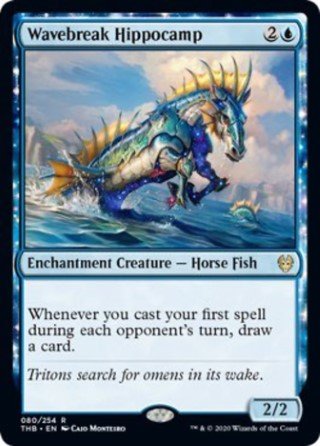
Wavebreak Hippocamp
AI Rating: 5Pro Rating: 1.0 // 3.5
This is definitely a build around, because it is nothing more than a 3-mana 2/2 in a deck that doesn’t have at least 5 ways to cast things on your opponent’s turn. That said, if you can draw even one card off of it, you’re in business, and more than that will be amazing.

Whirlwind Denial
AI Rating: 1.9Pro Rating: 1.5
This is a neat design for a counterspell that we haven’t really seen before. Most of the time in Limited, your opponent will just be controlling one spell or ability, so this is basically just a fancy Convolute, and that isn’t an amazing place to be. On occasion, you may be able to get more than just the one spell, but it isn’t that easy to make it happen.
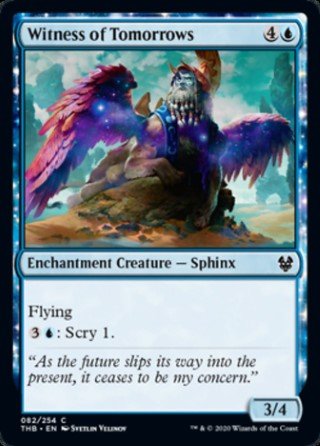
Witness of Tomorrows
AI Rating: 2.7Pro Rating: 2.5
Witness of Tomorrows tends to overperform. It lines up really well against most other flyers in the format as a ¾, and can be a really threatening presence in the air, and it doesn’t have the worst manasink ability either.
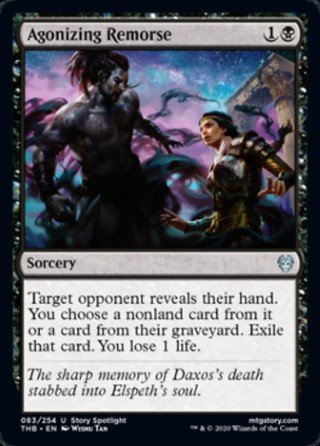
Agonizing Remorse
AI Rating: 3Pro Rating: 3.0
This is a great discard spell. It allows you to really disrupt your opponent early, and in the late game it can still do something – like exile a creature from Escape from their graveyard. That gets pretty close to still being a 1-for-1 late, and that’s what allows this to be a discard spell you actually feel good about in Limited – it does something all game long.

Aphemia, the Cacophony
AI Rating: 5Pro Rating: 4.0
Two mana 2/1 flyers tend to be good two drops in Limited, but Aphemia comes with the massive upside of turning Enchantments in your graveyard into 2/2 Zombies every turn, too. In a lot of sets actually getting Enchantments in your ‘yard might be a huge ask, but not here. There are a critical mass of Enchantments in this set, so most decks will have a decent number, especially because of Enchantment creatures. Sagas throw themselves in the graveyard too. Plus, there are lots of ways to mill yourself, especially in Black and Blue -- and that makes ite ven more likely you can make a few Zombies. Now, making a whole Zombie army is probably wishful thinking, but if you can get even just the two mana 2/1 flyer and a single 2/2 Zombie for only two mana, you’re doing an incredible job.

Aspect of Lamprey
AI Rating: 1.8Pro Rating: 2.0
Lifelink + Mind Rot turns out to be a pretty decent combination in this set. This is another Discard spell that still does a thing in the late game, and that’s nice, because it gets around some significant downside.
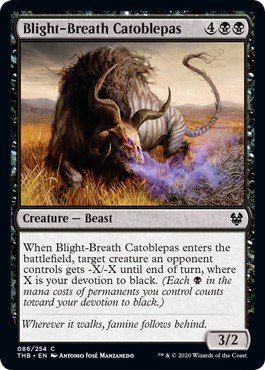
Blight-Breath Catoblepas
AI Rating: 2.8Pro Rating: 3.0
This typically lets you add to the board while subtracting from your opponents – even just killing a 2/2 with it, which it will always be able to do, is reasonable, and if you get your devotion higher it can be even more potent. That said, you don’t usually want more than one copy of this because its so expensive.
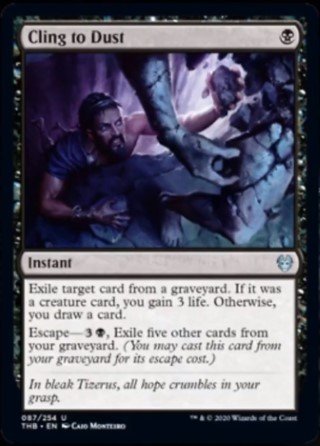
Cling to Dust
AI Rating: 1.6Pro Rating: 0.0
This isn’t worth a slot in your deck. The Escape cost is too high – in both mana and cards you have to exile – so ever being able to use this repeatedly is unlikely.
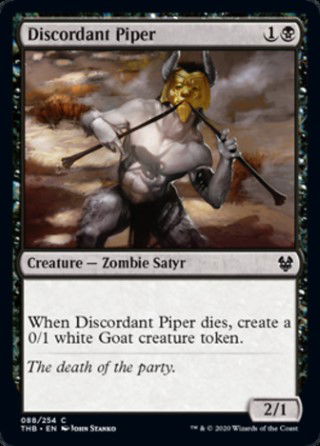
Discordant Piper
AI Rating: 2.3Pro Rating: 2.5
This starts as a two-mana 2/1, which is fine, and making an additional body is always a nice upgrade, even if the body is as irrelevant as a 0/1 goat. That is still a useful resource – either because you can use it to chump block, or maybe you can sacrifice it to something for value.
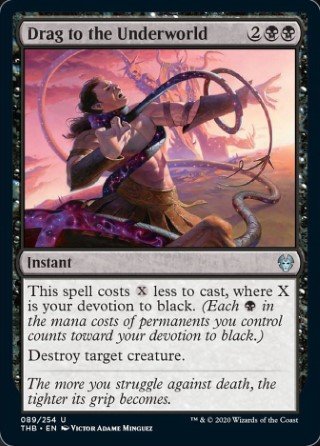
Drag to the Underworld
AI Rating: 4.4Pro Rating: 4.0
Now this is premium removal. 4 mana to kill anything at instant speed is already good and obviously 3 mana is Murder and this has the potential to only cost two Black mana! Now, it does matter that this can’t exile stuff -- since Escape puts extra value on cards going to the graveyard, but I think this is so efficient that it is really nitpicky to point that out.

Eat to Extinction
AI Rating: 5Pro Rating: 4.0
4 mana to kill something at Instant speed is already something you always, and this adds Surveil to the mix, which certainly doesn’t hurt. Killing something and then doing what you can to improve the quality of your next draw is going to feel pretty great. The fact you can put the card in the graveyard might actually be useful sometimes too. The fact it only has one Black in its cost is nice too, since it means splashing it won’t be that hard. Obviously the ability to kill planeswalkers is nice, but won’t come up for often in this format. you see it.

Elspeth's Nightmare
AI Rating: 4.1Pro Rating: 3.5
This can kill a large percentage of the creatures in the format with chapter I, and chapter II going after a card is some nice additional value. Chapter III is the one that really overperforms here because of the context of the format. Exiling a whole graveyard is a big deal, because there are a lot of graveyard things in this format. This is actually really good both early and late – early because it basically guarantees a 2-for-1, and late because it will kill something and then nuke the graveyard.

Enemy of Enlightenment
AI Rating: 2.9Pro Rating: 1.5
It is tempting to look at this as a potential finisher in your deck, but it is harder to consistently have it be a threatening presence than you might think, and you also have to contend with the symmetrical discard, which narrows the window in which you can play it. That said, it can be a finisher, but it isn’t a great one.
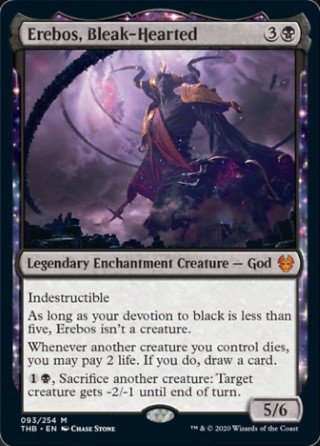
Erebos, Bleak-Hearted
AI Rating: 5Pro Rating: 4.0
This guy really underachieved in this format. He seems like he would be an incredible bomb, but it turns out -2/-1 doesn’t kill at as many things as you’d hope, and having the resources to sacrifice OR the life to pay to draw cards is no guarantee either. Now, I’m not saying he’s bad, mind you – he is still a great card and going to be one of the best cards in your deck – he just isn’t a bomb either.
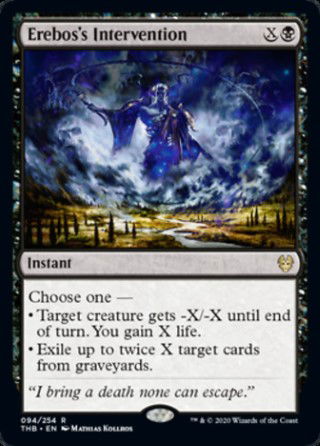
Erebos's Intervention
AI Rating: 5Pro Rating: 4.0
This scales all game long, and is capable of killing anything if the situation is right. Sometimes, X-costed Sorceries that are removal spells have the donwnside of making you tap out to kill one creature, which on some boards can be dangerous – but the life gain this gives you helps make that less of a big deal. Now, the second mode – the ability to exile stuff from graveyards – will only be what you want to do a small percentage of the time, but it does come up on occasion.
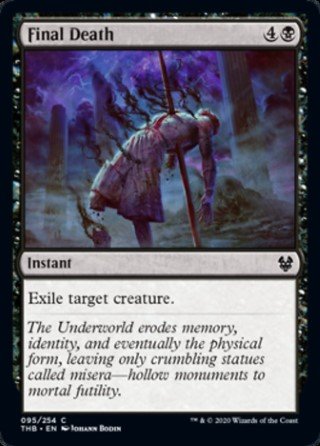
Final Death
AI Rating: 3.6Pro Rating: 3.0
It isn’t fancy, but Final Death is a nice common removal spell for Black. 5-mana to exile any creature at instant speed is nice, especially because this format loves the graveyard. For me, I think it still falls a little short of “premium” territory, but not by much.
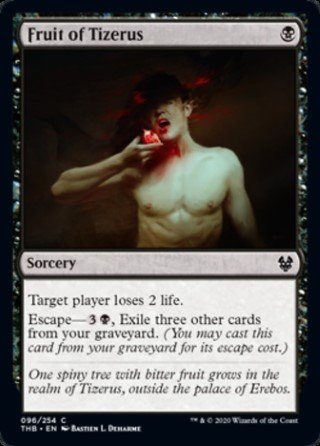
Fruit of Tizerus
AI Rating: 0.2Pro Rating: 0.0
This card is a trap. People look at it and think it will be a worthwhile win condition in a control deck, but setting up is way too hard, the resources it asks for basically put you behind the eight-ball, even as a control deck. You’d much rather just be adding to the board and using your graveyard resources to do so.

Funeral Rites
AI Rating: 1.4Pro Rating: 2.5
This is Black’s solid-but-unexciting draw spell in this format. It is nice it adds three cards to the graveyard for Escape.
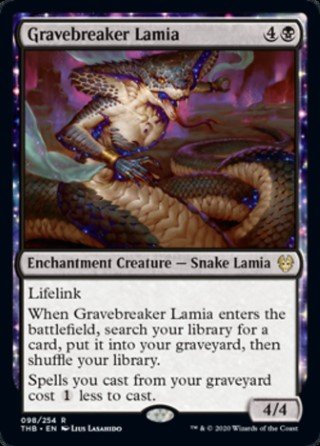
Gravebreaker Lamia
AI Rating: 4.9Pro Rating: 4.0
Lifelink is just such a nice keyword, since it can swing the game wildly in your favor – whenever this hits your opponent the life swing is EIGHT which is just massive. Sure, it isn’t very efficient – but Gravebreaker Lamia makes up for this by letting you tutor up whatever you want to put it into your graveyard, while also reducing the cost of cards you cast from the graveyard – which in this format, mostly means cards with Escape, which – again, will be cheaper to cast. This means that a lot of the time, this will amount to a 5-mana 4/4 with Lifelink that draws you a card, and that’s pretty darn good.
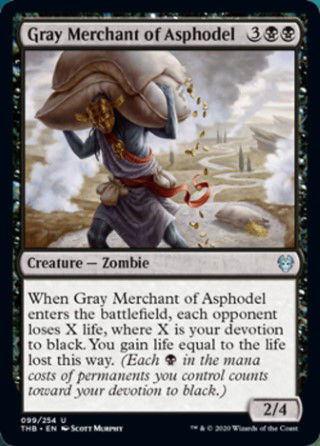
Gray Merchant of Asphodel
AI Rating: 4.3Pro Rating: 3.5
So, on a base level, the Merchant is a 5-mana 2/4 that drains the opponent for two. That’s not very good. However, I think once it is draining for three, you’re getting decent value for your mana.. If you are draining 4 or more, you are in serious business. I think the Merchant has a high enough ceiling that taking it with an early pick is probably a good idea. You may have to abandon it, if your deck doesn’t end up with enough Black, but that’s fine. The upside is worth it.
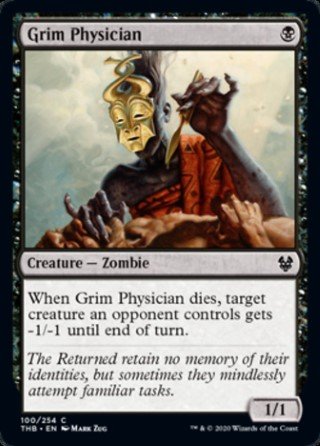
Grim Physician
AI Rating: 0.9Pro Rating: 1.0
This can trade for X/2s, or threaten a 2-for-1 against two X/1s. It isn’t a terrible thing to sacrifice. But you mostly won’t play it.
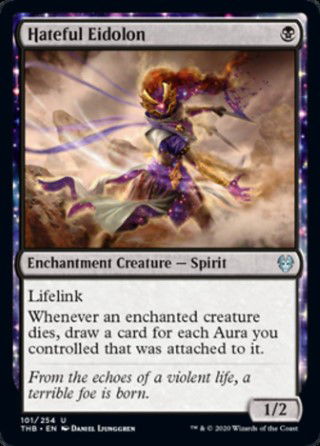
Hateful Eidolon
AI Rating: 3.4Pro Rating: 3.0
There are enough Black Aura-based removal spells in this set that Hopeful Eidolon draws you a card a little more often than you might think! That’s the most effective way to trigger its ability, but you can also do it with offensive Auras. And, the Eidolon counts itself, so if you put an Aura on it, it will at least replace itself if it dies. It is already a nice place for Auras too, as a result of lifelink.
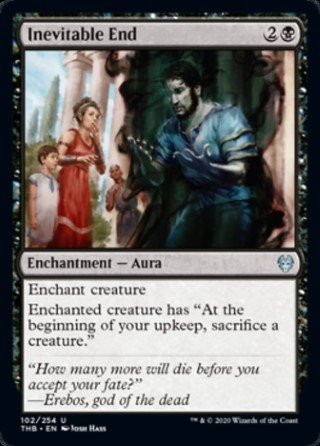
Inevitable End
AI Rating: 3.4Pro Rating: 2.5
I don’t love cards like this in most scenarios. Sure, if your opponent has one creature in play it will feel like premium removal -- but most of the time, your opponent will have other creatures -- including fairly expendable ones, and sometimes playing this card will be irrelevant -- and that isn’t what premium removal is supposed to be. I don’t think this is terrible mind you, especially because this set loves Enchantments, but it should not be taken early, and you should be running a bunch of Black removal over it.
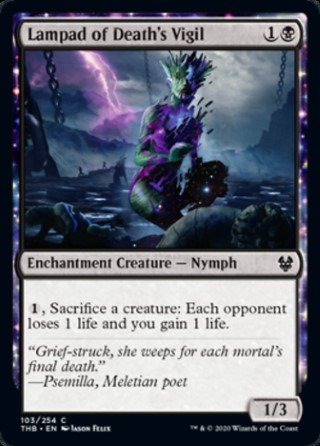
Lampad of Death's Vigil
AI Rating: 2.9Pro Rating: 3
This ended up being a key card in this format. Its cheap sacrifice effect made sacrifice decks a lot better than they would otherwise have been, and the fact it drains life often allows you to get to lethal a full turn or more before you would have had it otherwise.
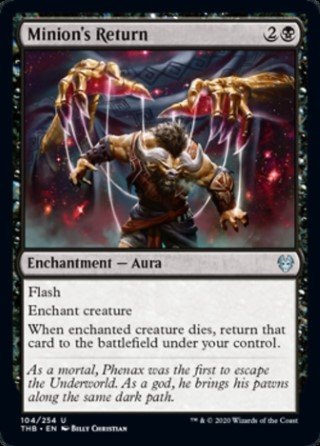
Minion's Return
AI Rating: 1.6Pro Rating: 1.5
Situational cards are not your friend in Limited, and that’s definitely what this ends up being. It is tempting to imagine using this to steal your opponents’ bomb, or keep yours alive, but there are plenty of games where things just won’t line up the way you want them to and this ends up being an underwhelming or worse – useless card.

Mire Triton
AI Rating: 4Pro Rating: 3.0
A two mana 2/1 that can kill anything in combat thanks to death touch is usually enough to be playable, but this brings some serious additional value -- both gaining you life and helping you stock your graveyard. Self-mill is very useful in this format thanks to Escape, and the UB archetype also seems focused on loading up the graveyard more generally.
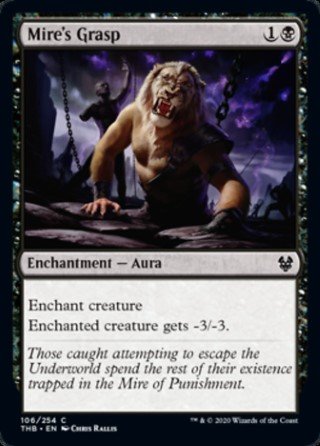
Mire's Grasp
AI Rating: 3.9Pro Rating: 3.5
This is premium removal. Two mana for -3/-3 is a good deal, and while I would probably prefer it to be an Instant rather than an Enchantment, the fact that you can only cast it at Sorcery speed is made up for, at least a little bit, by having the useful Enchantment type.
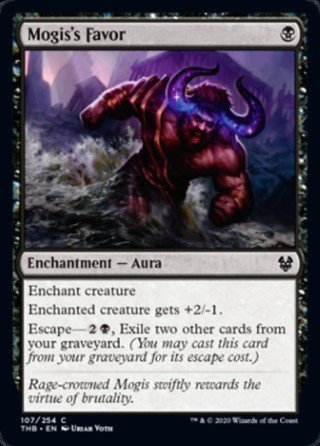
Mogis's Favor
AI Rating: 2.5Pro Rating: 2.5
This is surprisingly useful for a one mana card! You can use it to kill X/1s, and its relatively cheap Escape cost means you can threaten X/1s with it all game long. You can also put it on one of your evasive creatures as a way of doing significantly more damage.
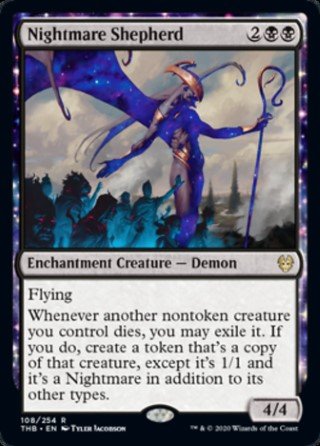
Nightmare Shepherd
AI Rating: 5Pro Rating: 4.5
This starts with really strong stats that can end the game on their own, and then it adds an extremely powerful ability to the mix. When any of your creatures die you get a 1/1 copy of it. Now, this can sometimes be a little bit of a nonbo, like if you lose an Escape creature as a result, but it is still mostly going to be worth it.
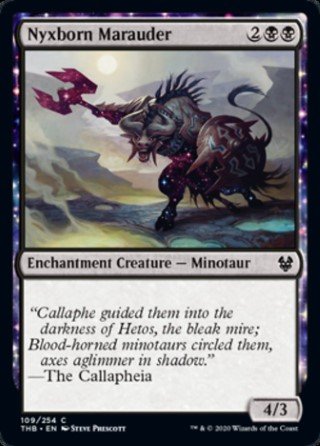
Nyxborn Marauder
AI Rating: 1.3Pro Rating: 1.5
This is an Enchantment that has alright stats and contributes to your devotion. You’ll play it sometimes.
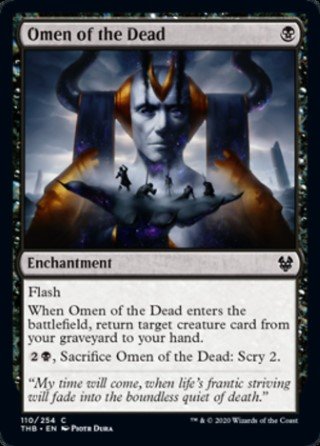
Omen of the Dead
AI Rating: 2.1Pro Rating: 2.0
This is nice and cheap, which is good news for Constellation. That said, unlike the other Omens, which can largely be played at any time for decent value, Omen of the Dead demands you have a creature in your graveyard, which means it can be a dead card for the first several turns. Like the other Omens, it can cash in and Scry, which isn’t too bad.
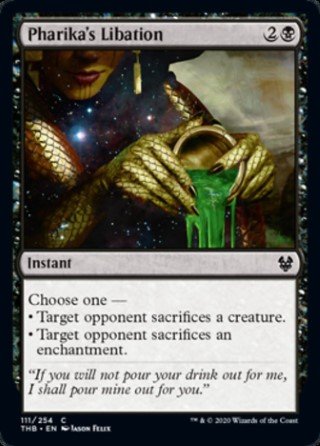
Pharika's Libation
AI Rating: 1.9Pro Rating: 2.0
Because you can choose what this Edict hits, you can often choose an option that takes out a pretty good permanent. It still has the downside of all Edicts – the bigger the board, the worse it gets.
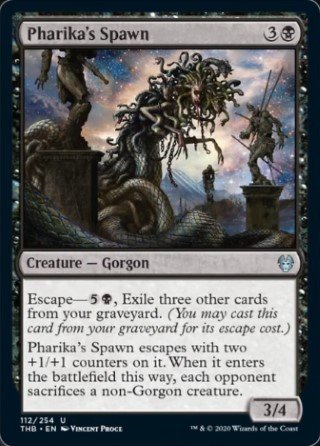
Pharika's Spawn
AI Rating: 4.4Pro Rating: 4.0
If you can trade using that ¾ body, and then later in the game pay 6 mana and helps this Escape from your graveyard, you end up with a ⅚ body that has an edict effect. One nice thing here is that because the Spawn is a Gorgon itself, if it is your only creature, you won’t have to sacrifice anything. The Spawn also asks for less cards to be exiled than most cards with Escape, so it doesn’t require as much additional effort to load the graveyard as many of these do. So, look -- if this was just a 4-mana ¾ that you could get back in the late game as a 6-mana ⅚, that would be a very playable card. While neither side is efficient, the fact that you get TWO creatures out of one card is some real value. And, obviously enough, this comes with the addition of an Edict effect.
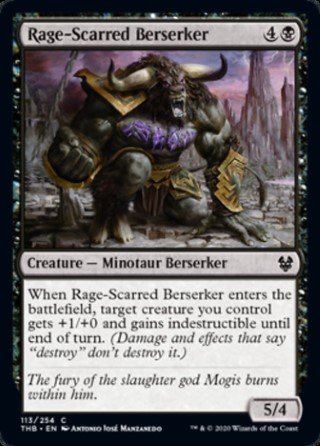
Rage-Scarred Berserker
AI Rating: 1.7Pro Rating: 2.0
This has okay stats and an ETB ability that will frequently allow you to make an attack you couldn’t before. He’s not bad.

Scavenging Harpy
AI Rating: 2.1Pro Rating: 2.0
Three mana 2/1 flyers are fine and this has some minor upside that will probably be a little bit less minor in this set -- since it has the ability to exile a card from the graveyard, so taking an Escape card seems pretty nice.
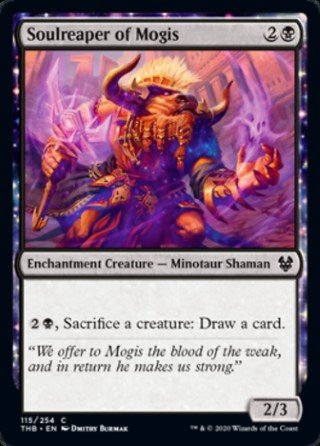
Soulreaper of Mogis
AI Rating: 2.5Pro Rating: 2.0
This has decent stats and an okay mana sink ability. The ability does feel pretty clunky, especially when there are cheaper sacrifice outlets around, like the Lampad.

Temple Thief
AI Rating: 1.5Pro Rating: 2.0
This is a Bear that is sometimes unblockable, but not really often enough to be that great.
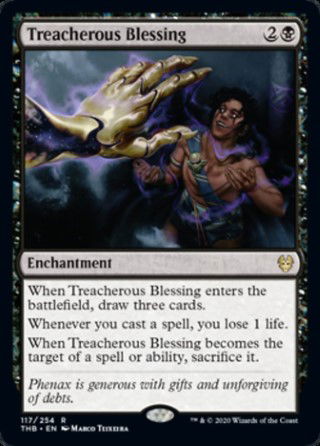
Treacherous Blessing
AI Rating: 4.8Pro Rating: 3.0
I’m always a big fan of Phyrexian Arena type cards, and that’s what this reminds me of. Three mana to draw 3 cards is incredibly strong, and it gives you the kind of card advantage that might just win you the game on its own. Sure, it comes with a significant downside, but I think that downside is almost always going to be worth it, as the cards that you net from this will often allow you to put your opponent away before the downside really matters. It is also nice that it comes with a bit of an escape clause, giving you a way to get rid of it if you have the right cards.
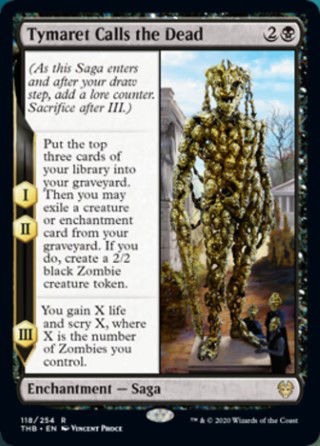
Tymaret Calls the Dead
AI Rating: 4.6Pro Rating: 3.5
It is surprisingly easy to get two 2/2 Zombie tokens out of this, and that’s good for the investment, especially because it also loads your graveyard for your other purposes, scries, and gains you some life.
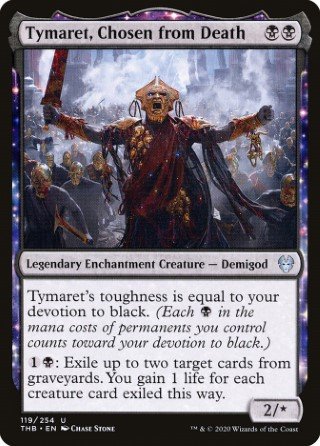
Tymaret, Chosen from Death
AI Rating: 3.9Pro Rating: 3.5
Like a lot of graveyard hate in this format, Tymaret overperforms. He can really mess up the game plan of the many decks in the format that rely on their graveyard, while giving you some pretty efficient stats.
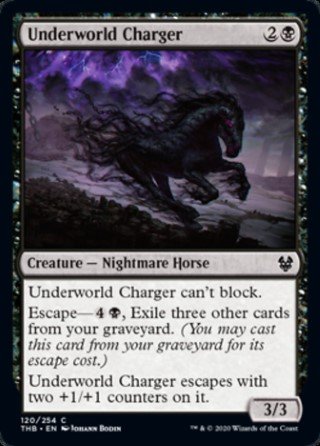
Underworld Charger
AI Rating: 2.4Pro Rating: 2.5
This is a fairly efficient aggressive creature who refuses to stay dead, and when it comes back it does so quite large! You can’t really play this anywhere but an aggro deck since it can’t block, but it works out pretty nicely there.

Underworld Dreams
AI Rating: 1.5Pro Rating: 1.0
Devotion is generally not a big enough theme in this set for Underworld Dreams to be worth it. It is too hard to cast and too slow for such a lame effect.
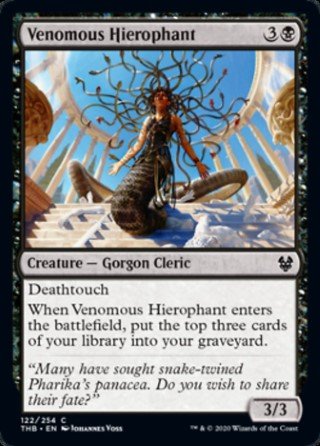
Venomous Hierophant
AI Rating: 2.9Pro Rating: 2.5
This loads your graveyard in a format that is interested in that, and it can trade for anything!

Woe Strider
AI Rating: 5Pro Rating: 4.5
Woe Strider is great. When you first play it you get an efficient creature who brings a 0/1 along for the ride. It also has a free sacrifice ability, which are sometimes sneaky good, since they can really let you abuse sacrifice synergies. But what really pushes Woe Strider from being merely a good card into being a bomb is the fact that it can Escape, and it does so reasonably efficiently. The Strider just keeps coming back as a 5/4 in the late game, and it also brings the 0/1 friend along with it. It tends to just grind out a win thanks to the attrition.
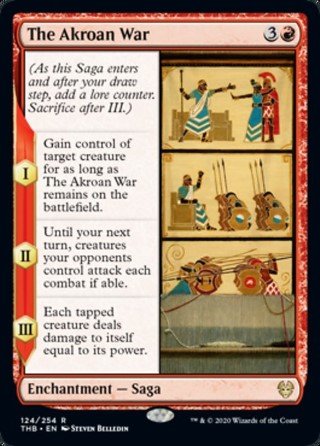
The Akroan War
AI Rating: 4.7Pro Rating: 4.5
4 mana to steal a creature is great, but keep in mind that unlike most Red effects like this, it doesn’t give the creature you steal haste. The upside though is you get to steal it for more than one turn -- you will have it for two turns instead! But this card does a whole lot more than that! It might take a little bit, but between stealing their creature, then forcing their creatures to attack you, and the final chapter of the Saga, you’re going to be killing stuff most of the time when you play this. Overall, I think this seems pretty powerful -- Chapter I you get a blocker out of the way who you can attack with next turn, Chapter II you can force your opponent into bad attacks, and Chapter III, most of your opponent’s creatures die. And you obviously get to avoid having your own creatures damage themselves, since your creatures don’t have to attack. Though, I would recommend attacking the turn before Chapter III with the creature you stole, so your opponent won’t get it back. Sometimes this won’t line up right, and that’s frustrating, but most of the time it works in your favor.
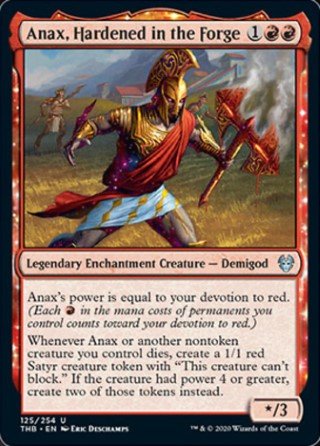
Anax, Hardened in the Forge
AI Rating: 4.2Pro Rating: 4.0
At worst, he is a 3-mana 2/3 with a powerful ability who churns out creature tokens when stuff dies. Now, the fact that those creature tokens can’t block is no small thing – part of the value of creature tokens in a lot of games is that they can provide chump blockers, and these can’t do that – they are all about attacking. So yes, that is definitely a downgrade, but still – you’re getting creature tokens when stuff dies, and that’s nice value. Plus, he also likes it when extra big creatures die, and he can make two tokens. It is nice too that this ability includes himself, so it basically impossible for your opponent to straight up trade with Anax – he can even potentially get his power up to 4, in which case he would make two tokens! I think that Anax brings a lot of power for an uncommon, especially as a three drop.

Arena Trickster
AI Rating: 0.9Pro Rating: 2.0
Red, and especially Red-Blue, has several payoffs for playing stuff on your opponent’s turn, and Arena Trickster is one of those – and he seems like he will be a solid card in that type of deck. Even getting one counter on this is pretty nice, and anything beyond that you start to feel really good about things. It also doesn’t hurt that you make it bigger at Instant speed, as sometimes that will really allow you to manufacture a blow out. Still, the UR deck doesn’t come together often enough for this to be great.
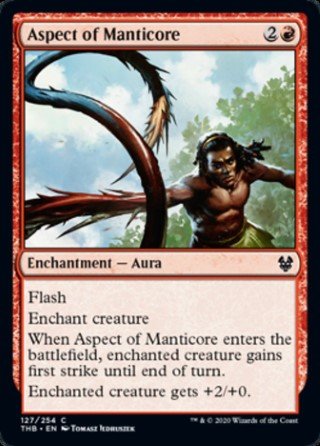
Aspect of Manticore
AI Rating: 1.5Pro Rating: 2.0
This is another Aura that feels like a combat trick that leaves some value behind, and the boost it often gives is well worth it in aggro decks. Still risky of course, so keep that in mind.

Blood Aspirant
AI Rating: 2.4Pro Rating: 3.0
He gets bigger when you sacrifice permanents, and also gives you a way to do that. His ability to ping a creature and make it unable to block is pretty powerful, especially because he will be getting bigger at the same time. He will often make your attacks look much better, if yo’ure willing to give up a creature or an Enchantment. There will of course be times where you just can’t get things going with the Aspirant, and that will hurt -- but there will also be games where activating his ability twice will just win you the game.
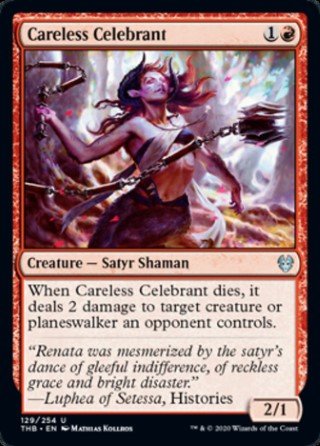
Careless Celebrant
AI Rating: 3.8Pro Rating: 3.5
A two mana 2/1 that is relevant all game long is always nice, and that’s what we have here. You can set up two-for-ones pretty easily with this, and that’s the ideal situation, but even if you can’t do that, you can just trade up with it – since it can take down anything with 4 toughness all on its own! Situations will be created where your opponent’s attacks just don’t work for them because of this two drop, and that’s going to feel pretty good.
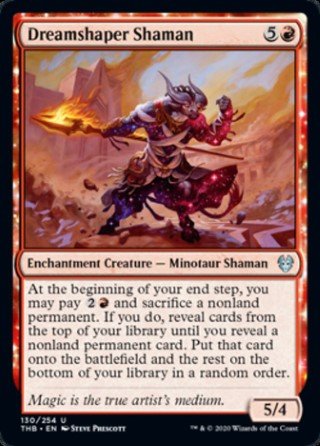
Dreamshaper Shaman
AI Rating: 1.8Pro Rating: 1.0
So, as usual, let’s start with the stats – 6 mana 5/4 is not good. But of course, this guy has a huge block of text, which allows you to sacrifice a permanent at each of your end steps, and then it does a typical Red chaotic thing – you get to put the top nonland card in your library on to the battlefield. Note, by the way, that he can sacrifice himself to the effect – that might come up in some scenarios. Anyway, how good is this type of effect? I don’t love it, mostly because of how random it is. Sure, you could get something awesome – but if you sacrifice a creature and pay 3 mana and get like, a medium Common, that’s not going to feel too good. Remember, when thinking about whether or not you’re getting a discount on getting something into play, you should be adding the CMC of the permanent you sacrifice and the 3 mana – and that just means it will be hard to make this work. Now, there are times when it could – namely, if your deck can make creature tokens, or if it has creatures that have nice abilities that trigger when they die, or even creatures with Escape. But still, I think it will be very difficult to come out ahead with this thing.
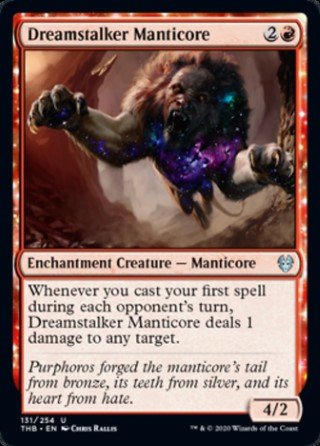
Dreamstalker Manticore
AI Rating: 2.7Pro Rating: 3.5
This starts with solid stats, and then has the ability to ping stuff if you cast a spell on an opponents’ turn. That ability often really complicates the board state for your opponent, especially if you have cards in hand on their turn. You can of course threaten to kill X/1s, but the Manticore can also help take down an attacker who was blocked, and can even go after the opponent when you need the reach.

Escape Velocity
AI Rating: 0.6Pro Rating: 2.0
This is a cheap Aura with Escape, and Escape really helps it get around the downside some Auras have – you won’t really be getting 2-for-1’d if they kill the creature you put this on, because it will keep coming back!
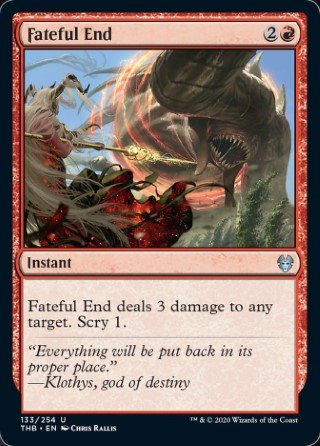
Fateful End
AI Rating: 3.9Pro Rating: 3.5
Well, it isn’t Lightning Bolt, or even Lightning Strike – but that’s ok, this is still premium removal. . It can kill stuff in response to Auras – which will be extra good in this format, as well as in response to combat tricks and other shenanigans, and it can kill the majority of creatures you’re going to see in this format, frequently trading up. Scry 1 might just seem like small value, and I guess it kind of is, but adding a little bit of card selection to a great removal spell is nice.

Final Flare
AI Rating: 1.6Pro Rating: 1.5
There aren’t many formats where removal spells that involve you sacrificing a creature end up working out in Limited, and this isn’t one of them, even with a fairly legit sacrifice deck around.

Flummoxed Cyclops
AI Rating: 1.5Pro Rating: 2.5
A 4-mana 4/4 with Reach and downside doesn’t sound amazing, but it actually lines up fairly well in this format. It is a sizable creature, and as long as you’re just always attacking with him, the fact he can’t block a big chunk of the time doesn’t matter! It is a little annoying that he has Reach – a purely defensive ability – but won’t be able to block with it very often. He does do a good job of stonewalling a board that has like…one flyer and not much else, at least.
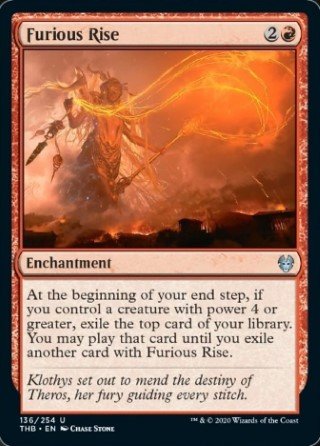
Furious Rise
AI Rating: 2.5Pro Rating: 1.0 // 3.5
This is a powerful 4-power build around that basically draws you a card every turn when you meet the requirement. Your deck has to have the right composition, but when it does, this will win you games.
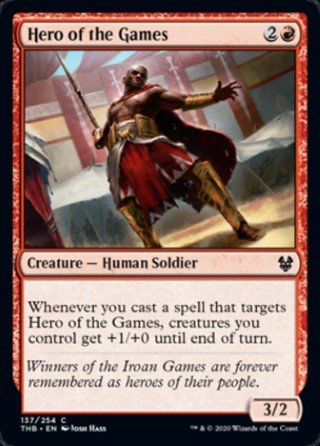
Hero of the Games
AI Rating: 1.2Pro Rating: 2.0
This has decent stats, and targeting it with stuff pumps your whole board, which is nice.
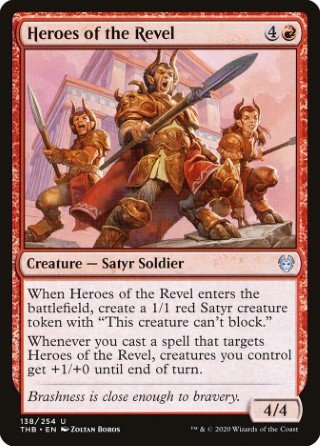
Heroes of the Revel
AI Rating: 3Pro Rating: 3.5
So, this is 5-mana for a 4/4 and a 1/1, and it comes with the “Hero” clause – pumping the power of all of your creatures when you target it. That’s a pretty good deal, especially because the Heroes themselves help you go wide in the first place.
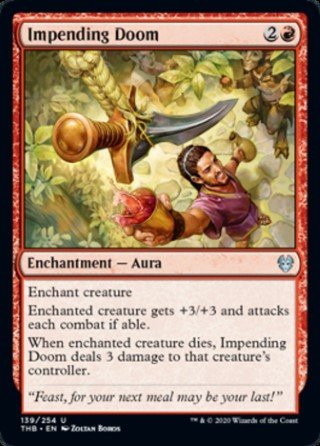
Impending Doom
AI Rating: 1.2Pro Rating: 2.0
This gives a really nice stats boost for the cost, though it does come with some quite significant upside. If you’re an aggressive deck, slapping this on your one or two drop can often win you the game – but of course you’re going to get 2-for-1’d and Lightning Bolted if your opponent has an answer. This tends to be worth it in those aggro decks, but not really anywhere else.
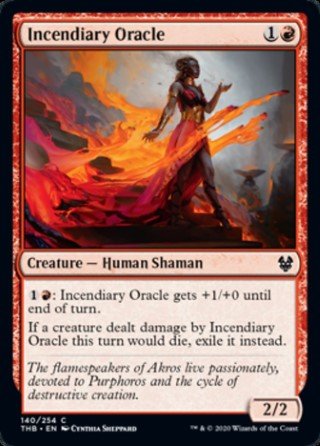
Incendiary Oracle
AI Rating: 2Pro Rating: 3.0
This has nice stats and some really significant text. Pumping power is nice, because it allows it to threaten to hit hard when you have all your mana open, and can trade for lots of stuff, and the exile clause also comes up in this graveyard-heavy format.
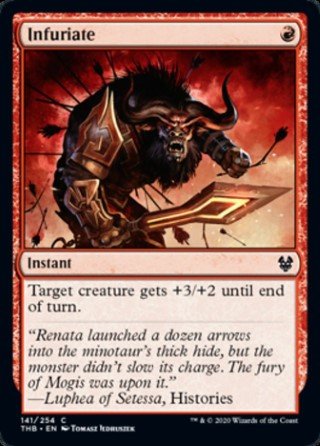
Infuriate
AI Rating: 1.1Pro Rating: 1.5
This is an alright trick. You’ll play it sometimes in aggro decks.
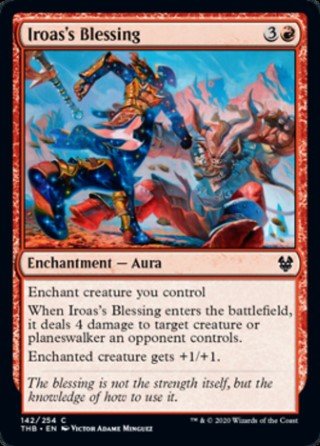
Iroas's Blessing
AI Rating: 3.5Pro Rating: 3.5
This is a removal spell that also gives one of your creatures a stats boost, and that’s pretty nice. It isn’t the most efficient at removing things, but it is nice that it actually impacts your side of the board too, even if +1/+1 isn’t always going to be a major thing.

Irreverent Revelers
AI Rating: 0.6Pro Rating: 0.5
There aren’t really enough Artifacts in this set for this to be worth it in your main deck. If you go up against someone with a few targets though, this can become a 2-for-1.
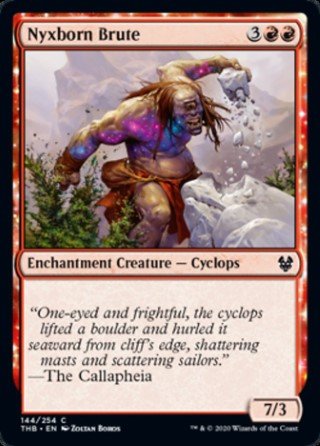
Nyxborn Brute
AI Rating: 0.4Pro Rating: 0.5
This is a big dumb creature who can die to almost all the removal in the set despite costing 5 mana. I think most of the time you won't be playing him.

Omen of the Forge
AI Rating: 2.9Pro Rating: 3.0
Two mana to do two to anything at Instant speed is usually a solid card, if not premium removal. Adding some scry to the later game doesn’t hurt either. Then this gets a little bonus for both being an Enchantment, and a card with Flash -- since there are decks in this format interested in both things. This is cheap enough too, that killing 3 and 4 mana creatures who have two toughness with it will happen a decent chunk of the time. Sometimes you’ll break even on it, but I think you’ll trade up enough that this will feel really good.

Oread of Mountain's Blaze
AI Rating: 1.1Pro Rating: 1.5
This has decent stats and it can loot – though for a significant mana investment. Still, being an Enchantment and loading the graveyard are two relevant things in this format.
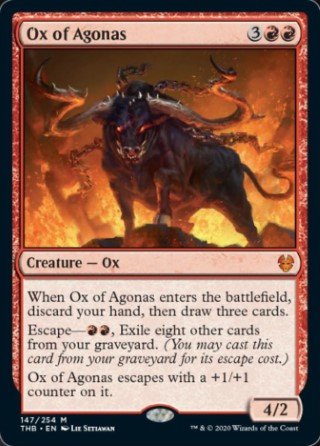
Ox of Agonas
AI Rating: 5Pro Rating: 4.5
This is a really neat card. 5 mana for a 4/2 that, in most cases, will be netting you at least a couple of cards is really sweet. And, the fact that he helps stock up your graeyard so you can bring him back later with Escape is some nice internal synergy. This is the kind of card that doesn’t have impressive stats, and it won’t be your win condition exactly, but the amount of cards it nets you -- especially if you manage to get it back with Escape later -- is completely absurd, and will be enough to win you the game on card advantage alone. I also like the high power, because it means finding a way to trade with the creature itself isn’t too hard. The one place where this might not feel great is if you are trying to hold on to some cards in your hand, but the good news is you can wait to cast this until it is as beneficial as possible.

Phoenix of Ash
AI Rating: 4.7Pro Rating: 4.5
A 3-mana 2/2 with Flying and Haste is already good -- then, the Phoenix comes with the ability to pump its power if you pump mana into it, which means even if your opponent manages to get something with Reach or Flying into play, the Phoenix can take it down if it needs to. Then, like all Phoenixes, Ash Phoenix can rise from the ashes, and in this case come back as a 3/3 with Flying and Haste. It also only asks for three cards to be exiled to Escape, and because of that Escaping with this over and over again isn’t really far-fetched. That means this Phoenix is going to be a nightmare for opponents, constantly coming back and dealing lots of damage in the sky. While this Phoenix is small, I think that its recursion and efficiency are enough to make into a bomb.

Portent of Betrayal
AI Rating: 1.3Pro Rating: 0.0 // 2.5
There is a real sacrifice deck in this format, and that means this Threaten effect is actually worthwhile sometimes! Stealing an opposing creature and then sacrificing it is one of the sweetest things you’ll ever do in Magic, and because there are good sacrifice outlets in this format, you’ll actually set that up sometimes. It is unplayable pretty much everywhere else, though.
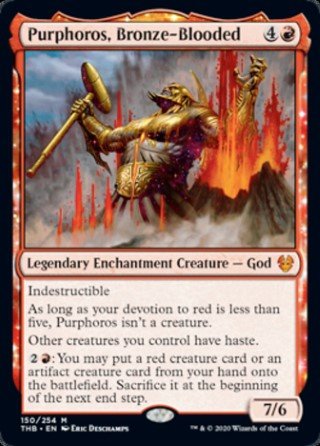
Purphoros, Bronze-Blooded
AI Rating: 5Pro Rating: 3.0
This is not the most impressive god. The best ones are the ones that have a nice baseline, even if you never manage to get devotion high enough, and I think Purphoros falls short there. Haste to your whole team is nice, as his “Sneak Attack” ability, but Sneak Attack type effects really aren’t that great in Limited -- it isn’t like you’re going to have Emrakul in your hand, you know? And sure, he is huge and indestructible when you get your devotion high enough -- and that’s awesome, but I think his somewhat lackluster other abilities keep him from being a super impressive card.
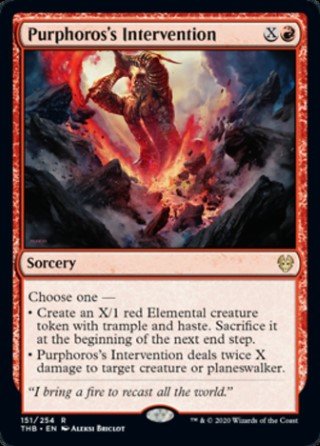
Purphoros's Intervention
AI Rating: 5Pro Rating: 4.0
This either gives you a flexible and very efficient removal spell, or a hasty elemental token. I think more often than not, you’ll want the removal option here – it isn’t the most efficient thing at only two mana – since it does 2, but that’s the least efficient it gets! At 3 mana you are doing 4 damage, and at 4 mana you are doing 6! This will be capable of taking down almost anything, and it does it at a discount. The other mode isn’t as attractive in most cases, but sometimes your opponent’s shields will be down, and you can make the Elemental token and win the game. The X damage part doesn’t let you hit players, but if that’s what you’re interested in doing, that Elemental token can help with that.
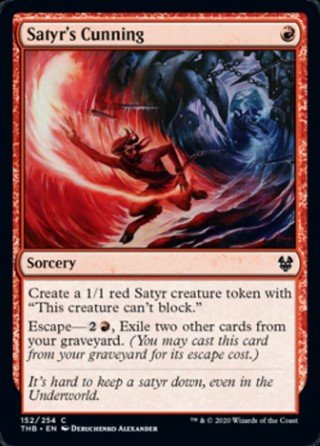
Satyr's Cunning
AI Rating: 0.5Pro Rating: 0.0
Making unblockable tokens over and over again and using up your valuable graveyard resources and mana just isn’t worth it.

Skophos Maze-Warden
AI Rating: 2.3Pro Rating: 3.0
So, a 4-mana ¾ that can raise its power while lowering its toughness is probably already something you’d play a reasonable chunk of the time. That ability means it can trade with anything, and also that every time you attack with it, if your opponent doesn’t block, they could be about to eat 6 damage. But the Guardian also comes with the very specific upside of making your Labyrinth of Skophos way better, since the Minotaur will now fight anything you target with it. Now, the Labyrinth is a rare and this is an uncommon, so the chances of getting them both together are pretty low, but when you do, it will feel pretty good.
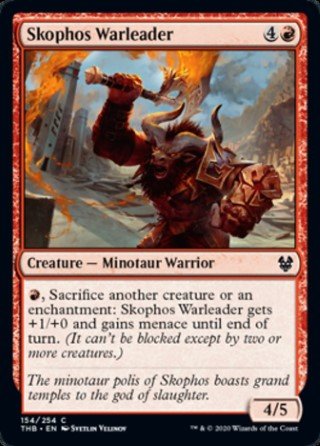
Skophos Warleader
AI Rating: 1.2Pro Rating: 2.0
This is another cheap sacrifice outlet, which works quite well in the BR deck. It is pretty inefficient other than that, though.
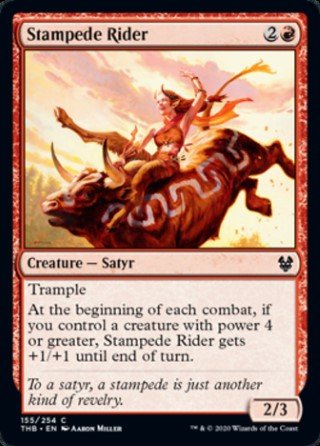
Stampede Rider
AI Rating: 1.4Pro Rating: 3.0
This is a great Common payoff for the 4-power deck, as it often will be a ¾, and in a set with lots of Auras, trample is pretty nice! Note by the way that it counts itself when looking for 4 power, so if you have suited him up with an Aura that allows him to have 4-power, it will still get the boost.
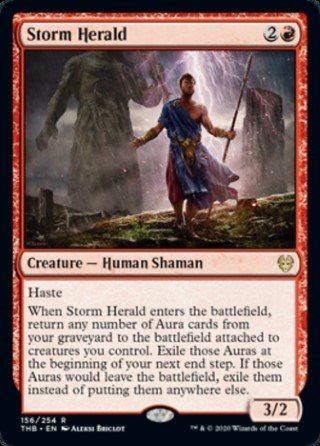
Storm Herald
AI Rating: 4.5Pro Rating: 3.5
This starts with decent enough stats, and he comes with a potentially game-breaking Enter the Battlefield trigger, since it lets you bring back Auras that are in your graveyard for a turn. This format is loaded up with Enchantments, and the idea of getting one Aura into the graveyard for this to take advantage of it isn’t something that is super crazy to imagine, and if you can do that consistently, you’re going to be getting a lot of value for only three mana, and probably adding a ton of hasty damage to the board. So ideally, for this to be at its best, you have to both be running a few Auras, and have some ways of loading up your graveyard, so you can -- as consistently as possible -- get an Aura or two back with the Herald. That IS significant set up, but because a 3-mana 3/2 with Haste is already fine, you aren’t making a big commitment there.
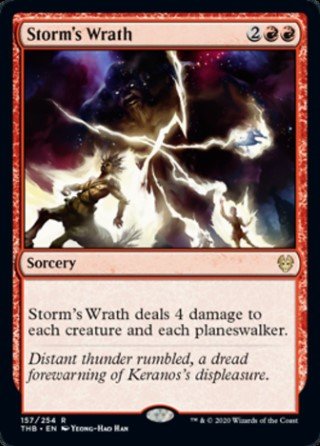
Storm's Wrath
AI Rating: 5Pro Rating: 4.5
As usual, Board sweepers are really strong in Limited, and this kills almost everything in this format. They are hard-to-replace effects that just completely reshape the game. And sure, they are obviously symmetrical, but because you’re the one with Storm’s Wrath you know its coming – your opponent doesn’t, and that is often enough for you to come out ahead.
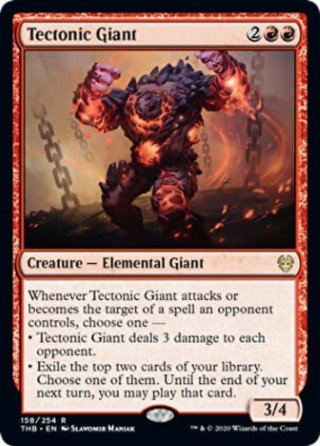
Tectonic Giant
AI Rating: 5Pro Rating: 4.5
Tectonic Giant comes with fairly decent stats as a 4-mana ¾, and an ability that triggers every time he attacks. And, his ability is pretty flexible! Sometimes you’ll want the damage, especially if your opponent’s life is in danger. Other times, you’ll want the shot to cast some extra cards, if you are trying to pull back ahead. So, you repeatedly can get a pretty powerful effect out of it. And, even if your opponent kills your Giant right away, you’re going to get value out of it, since it gives you one of those two abilities when it becomes targeted by the opponent too!
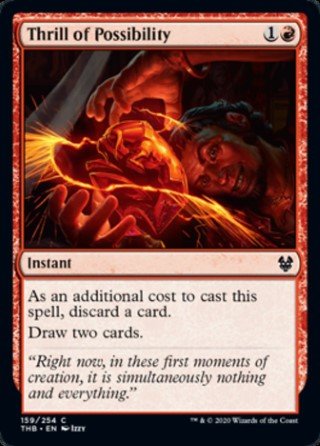
Thrill of Possibility
AI Rating: 1Pro Rating: 2.0
This gives you some nice card selection, loads your graveyard, and provides an instant speed effect for the UR deck, so it fits into most decks in this format reasonably well.
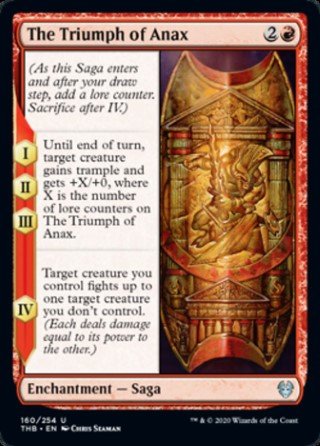
The Triumph of Anax
AI Rating: 1.5Pro Rating: 1.0
first three chapters help make it so your creatures can attack harder and give them trample, and if you play this on turn 3 and your opponent has an empty board you can start doing a ton of damage. But, that’s the kind of ability that normally won’t scale very well as the game goes on -- sure, if you have creatures who are challenging to block it gets more interesting, but the boost to only power and Trample just isn’t something I’m that interested in. I feel like most aggro decks would rather just play a 3-mana creature than this. Now, the fourth chapter of this Saga is the most interesting one, since it gives you a fight effect -- but the fact your opponent KNOWS it is coming, means they can play around it to some extent -- it just takes so long for you to get to chapter 4 too.

Underworld Breach
AI Rating: 4.7Pro Rating: 0.0
This is too difficult to set up in Limited. Don’t play it.

Underworld Fires
AI Rating: 0.1Pro Rating: 0.5
This is mostly a sideboard card. It just doesn’t kill enough in this format to really make it worth it in the main deck.

Underworld Rage-Hound
AI Rating: 2.2Pro Rating: 3.0
This is a key common for Red aggro decks in this format. It has reasonably aggressive stats and doesn’t tend to stay dead, and can really represent inevitability.

Wrap in Flames
AI Rating: 0.6Pro Rating: 1.5
This is alright in aggro decks, as it can let you close out a game, but it is still highly situational – it doesn’t tend to do much unless you have lethal.

Arasta of the Endless Web
AI Rating: 5Pro Rating: 4.0
So, a 4-mana ⅗ with Reach is pretty darn efficient, and you’re going to get ½ spiders out of this often enough for it to be pretty nice. The fact is that this can block most of the flyers in the set, and your opponent is going to be frustrated with that, and if they want to get it or other creatures off the board, they’re going to have to give you a ½ spider in most cases, though there is Aura-based removal in this set.
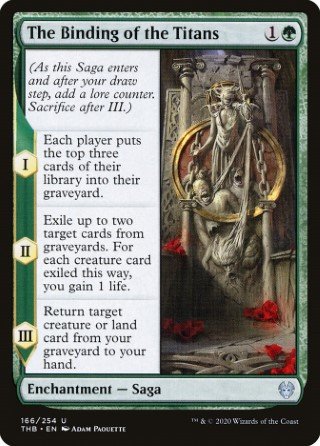
The Binding of the Titans
AI Rating: 2.7Pro Rating: 1.0
This is a super slow Green Anticipate, and I’m not that interested in that.
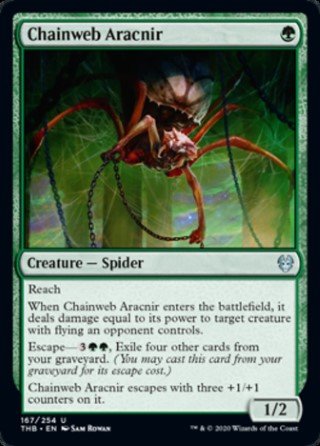
Chainweb Aracnir
AI Rating: 3.4Pro Rating: 3.5
Like most Escape creatures, Aracnir tends to give you some pretty nice card advantage. Early it isn’t the most impressive creature, but even just chump blocking with it feels pretty good, since it can come back in the late game and knock a flyer out of the sky as a 4/5.
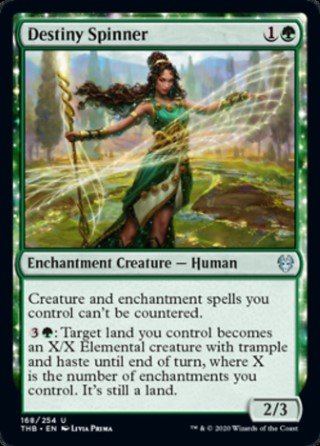
Destiny Spinner
AI Rating: 4.1Pro Rating: 4.0
This little two drop is good all game long. It has good stats, and it can animate your lands into pretty scary attackers in the late game, when it can often take over.
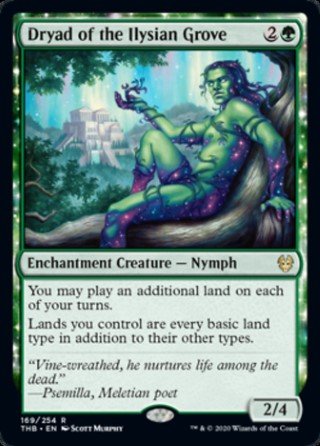
Dryad of the Ilysian Grove
AI Rating: 4.6Pro Rating: 3.5
This has alright stats and the Dryad’s ability to let you play additional lands, and make your lands into every basic land type is pretty nice. The former helps you ramp some, and the latter is pretty amazing fixing. Now, I think people sometimes overrate effects that let you play additional lands in Limited. This is because that ability becomes increasingly pointless pretty quickly – you just will be out of extra lands to play in a hurry – though, if your deck has lots of ways to draw cards, it probably does get a little better. Don’t get me wrong, the ability is nice, but I think a lot of people imagine just playing two lands a turn every turn with this, and that just won’t happen. The fixing this provides is also pretty incredible.

The First Iroan Games
AI Rating: 5Pro Rating: 4.0
This is good, as it will usually be well worth the 3 mana you spend on it. Even if you have nothing going on on the board, it helps add to the board for you, then makes the creature big, and can then also draw you a card. Obviously, your creature has to survive to the third chapter to draw that card, and sometimes it won’t – but most of the time you’ll also have more than just this 1/1 in play, too! The final chapter is probably the least impressive in most cases, but hey, at least it helps you fix and ramp your mana.

Gift of Strength
AI Rating: 1Pro Rating: 1.0
This is an alright trick, but in a format with lots of playable offensive Auras, tricks are a little less valuable.
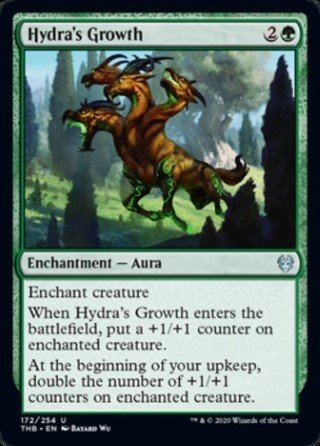
Hydra's Growth
AI Rating: 3.5Pro Rating: 1.5
This comes with all the downside of Auras – it can lead to card disadvantage from those 2-for-1s and so forth, and the initial boost it gives for three mana is not worth that risk. A single +1/+1 counter just isn’t enough – and I don’t think two is enough either to offset the risk. This means there are two turns where your investment looks ugly, which gives your opponent extra time to get rid of this before you’ve gotten a reasonable amount of value out of it. Once it has added 4 counters you’re probably getting there, but that just takes so long.
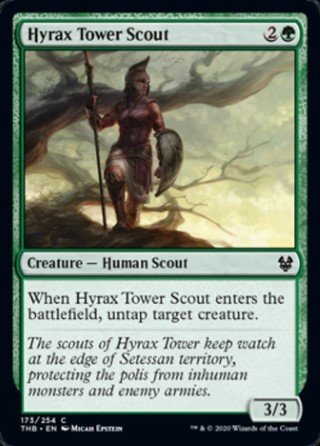
Hyrax Tower Scout
AI Rating: 1.5Pro Rating: 1.5
This has solid stats, and its ETB ability will occasionally do something, though not usually anything especially meaningful.
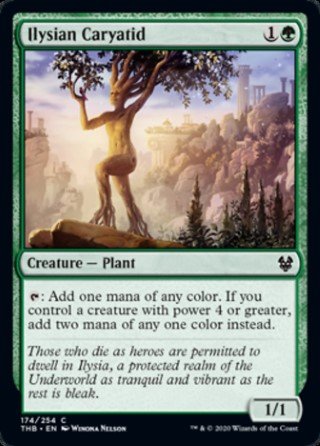
Ilysian Caryatid
AI Rating: 3.1Pro Rating: 3.0
This gives you some nice fixing that gets better if you have a big guy around. It is super vulnerable and dies to every removal in the set, which is especially painful when your opponent spend only one mana to kill it, but it is still a high quality common.
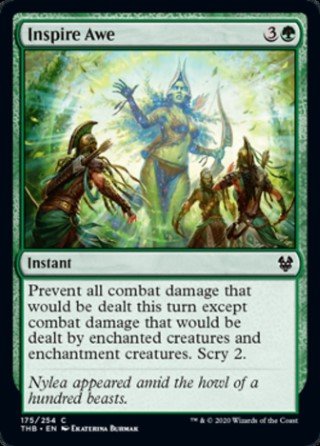
Inspire Awe
AI Rating: 0.2Pro Rating: 0.0
Fogs are unplayable in Limited 99% of the time. You use up a card for no real effect. This is not the 1% where that’s not true.
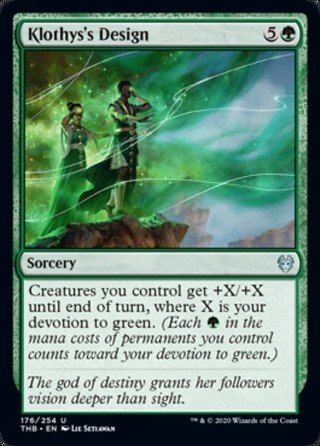
Klothys's Design
AI Rating: 1.8Pro Rating: 1.0
Six mana for a board pump effect like this honestly isn’t that impressive, especially because the boost it gives is so inconsistent, and it doesn’t even offer a keyword ability to sweeten the deal. You’ll play this in some of your Green decks, especially if you’re close to mono-green and going wide, but you’ll barely every play this.

Loathsome Chimera
AI Rating: 2.5Pro Rating: 3.0
Another nice Escape creature, the Chimera offers the ability to trade as a result of its high power, and then it can just keep coming back and threatening the opponent as a 5/2.

Mantle of the Wolf
AI Rating: 5Pro Rating: 4.0
This powerful Aura helps mitigate against the dangerous aspect of Auras – it keeps a 2-for-1 from really happening, because it gives you two Wolf tokens when it goes to the graveyard. 4-mana for +4/+4 to a creature is reasonably efficient too, especially when it is combined with the Wolf trigger, you are left with a pretty nice card. Your opponent might be able to deal with your huge Enchanted creature, but at least you are left with a couple of wolves who can be the targets of new Auras, can trade with stuff, or at worst – chump block things. And, 4 mana for two 2/2 wolves is actually a pretty reasonable rate! Keep in mind, though, that if the creature you are trying to put this one is killed in response, you won’t be getting those wolves, so it still comes with the downside of a lot of Auras – which is, playing it into your opponent’s untapped mana shouldn’t really be done, unless your opponent is out of gas, or you’re desperate. Most of the time though, finding a window to cast this won’t be too hard.

Moss Viper
AI Rating: 2.1Pro Rating: 2.5
One-mana 1/1 Deathtouchers are always solid playables, they can trade with anything, which is especially appealing for a card that only costs one mana.
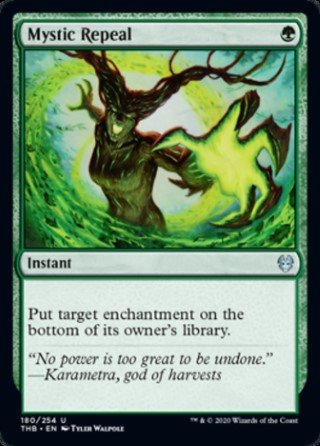
Mystic Repeal
AI Rating: 3.1Pro Rating: 3.5
This can tuck a huge number of permanents in this set and it does it really efficiently, basically amounting to being premium removal.
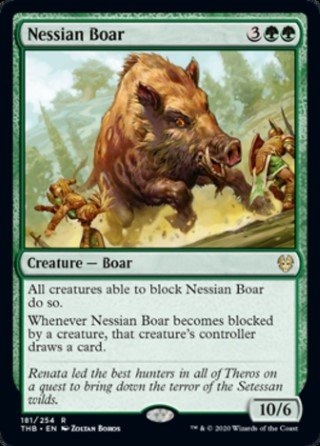
Nessian Boar
AI Rating: 4.7Pro Rating: 3.5
This has some pretty impressive stats, and a lure effect. Basically if you attack with your whole board, your opponent can only block the Boar so you know everything else will get in, and that’s great! What won’t feel so great sometimes is the fact that every creature your opponent has to put in front of the boar draws them a card – so they end up sort of breaking even on the exchange, or potentially doing even better if they can take down the Boar. If the boar does survive to do its thing again on the next turn, you probably win, as a second attack with your whole board should mean the end of your opponent. If your opponent survives this initial attack though, they’ll often be able to stabilize thanks to the cards you gave them. In other words, the Boar is really swingy and inconsistent, but the ceiling is high enough that I like it a fair bit.
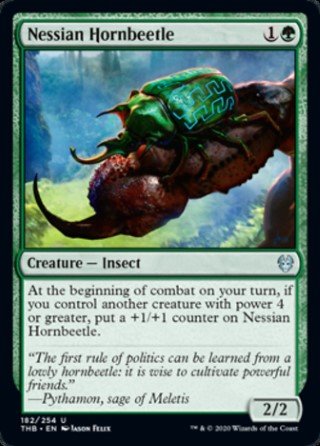
Nessian Hornbeetle
AI Rating: 4.2Pro Rating: 3.5
This is a great payoff for the 4-power deck, as it will often grow in size quickly enough to represent a real problem for your opponent, and it starts with decent stats to begin with!
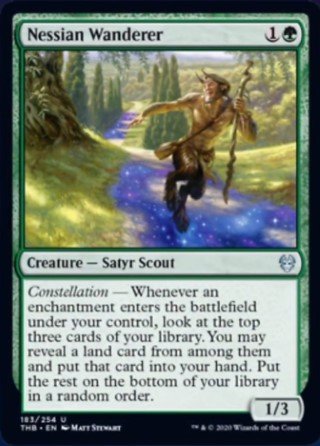
Nessian Wanderer
AI Rating: 3.7Pro Rating: 3.0
People tend to underrate this type of effect. Sure, all he does is draw you a land when you play an Enchantment, but drawing cards is drawing cards, and guaranteeing you hit land drops – or find mana for your splash – is pretty good. If he sticks around long enough, he thins out your deck significantly and gives you much better spell density.

Nexus Wardens
AI Rating: 1.9Pro Rating: 2.5
This is a real overperformer in this format. The stats line up quite well against the aggressive decks, and gaining life also makes their lives pretty difficult. This tends to be a pretty key Common for the more controlling decks in this format.
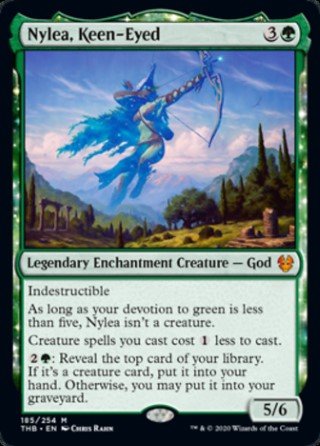
Nylea, Keen-Eyed
AI Rating: 4.9Pro Rating: 4.5
A 3 mana enchantment that makes creatures cheaper, and has a useful mana sink ability usually plays pretty nicely, as it is a great way to grind out longer games. And obviously, if your devotion gets high enough, Nylea becomes a huge indestructible creature.
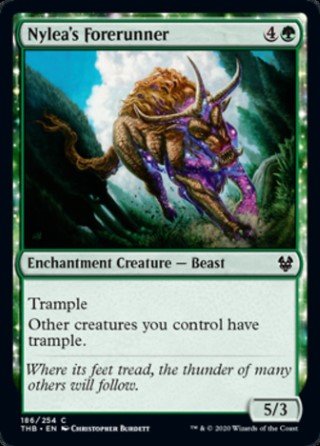
Nylea's Forerunner
AI Rating: 2.7Pro Rating: 2.5
This is a solid creature that is especially good in the 4-power deck, as giving Trample to everybody is likely to have an immediate impact in a deck with enough larger creatures, and of course the Forerunner packs more than 4 power itself!
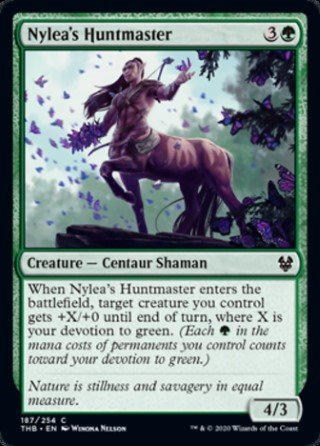
Nylea's Huntmaster
AI Rating: 1.7Pro Rating: 2.0
This has alright stats and a decent ETB trigger, though it is kind of a bummer it only increases power. This makes it harder for it to create an attack for you where a creature is now able to survive combat, instead it will just make it hit harder.

Nylea's Intervention
AI Rating: 4.4Pro Rating: 1.0
This normally just doesn’t do enough for the investment. If you can get it to kill a flyer or two it will feel pretty good, but that alone is mostly a sideboard effect. It does also help you splash, since it lets you search up lands, but overall it is just too slow and clunky to be worth it.
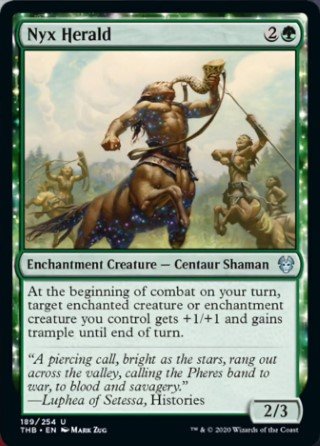
Nyx Herald
AI Rating: 4Pro Rating: 3.5
On its own, this is a 3-mana ¾ with Trample, and in most ways it is better than that, because it can spread that stats boost and keyword ability to other creatures.
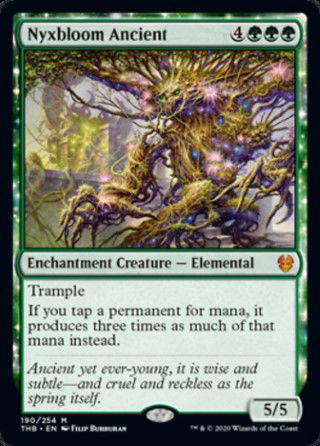
Nyxbloom Ancient
AI Rating: 3.5Pro Rating: 0.5
This card is cool and exciting, but in most games of Limited by the time you play him, he’ll just be a huge creature. You won’t find yourself in need of absurd amounts of mana – the 7 you pay to cast him will be enough to just about everything you want.

Nyxborn Colossus
AI Rating: 1.5Pro Rating: 1.5
This is reasonably efficient, has the Enchantment type, and increases your devotion. You’ll play it at the top of your curve in Green decks sometimes, though you’re probably holding out hope for something better.
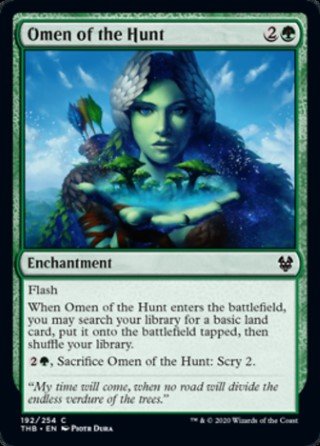
Omen of the Hunt
AI Rating: 2Pro Rating: 2.5
This is nice fixing and ramp, and like all Omens it can be cashed in to Scry later in the game. If you aren’t splashing it probably isn’t something you’re super interested in playing.
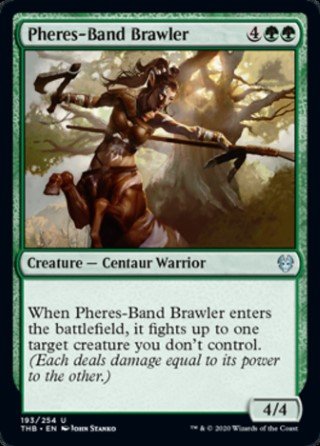
Pheres-Band Brawler
AI Rating: 4Pro Rating: 3.5
Creatuers with an ETB removal effect always feel great in Limited, since they allow you to develop your board while taking away from your opponents’. As a 4/4, the Brawler will be able to take down a big chunk of creatures in the set while it sticks around to trade with something else. That goes a long way towards helping you pull back even with an opponent who was ahead of you.
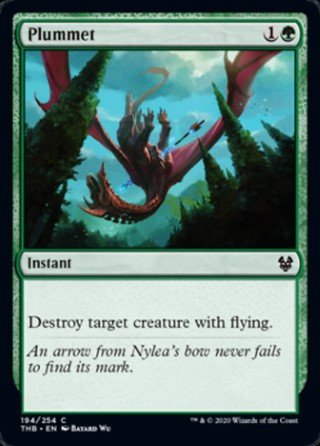
Plummet
AI Rating: 0.5Pro Rating: 0.5
This is mostly a sideboard card, but one you end up bringing a significant chunk of the time, provided you see a few flyers in game one.
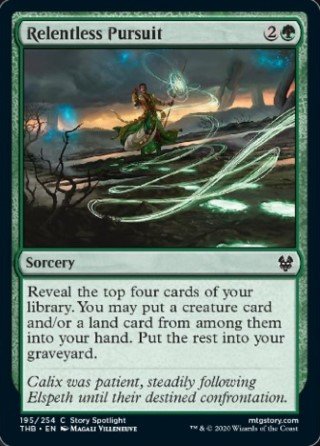
Relentless Pursuit
AI Rating: 1.1Pro Rating: 2.0
This is a solid draw spell for Green, and it is nice that it puts at least three cards in the graveyard when you use it, because that will help you fuel Escape.
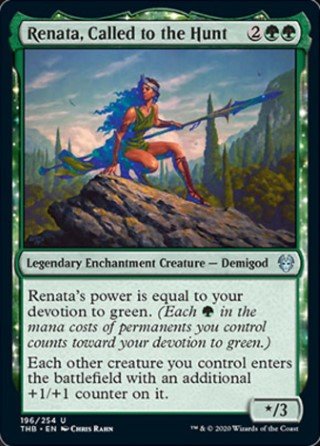
Renata, Called to the Hunt
AI Rating: 4.2Pro Rating: 4.0
At worst she is a 4-mana 2/3 that makes your creatures come down with an additional counter – and that’s a card you would pretty much always play. But, the higher your devotion, the higher the power, and the more impressive she becomes.
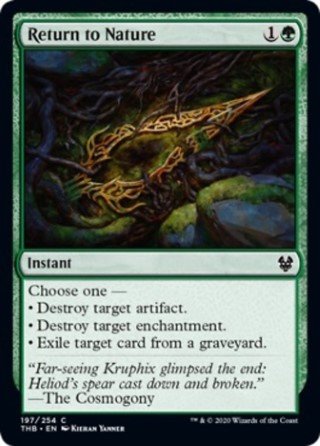
Return to Nature
AI Rating: 2Pro Rating: 2.5
You can main deck this pretty easily in this format – there are Enchantments everywhere, and sometimes exiling an Escape creature is worth it.
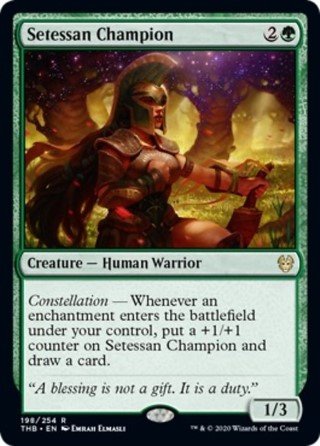
Setessan Champion
AI Rating: 5Pro Rating: 4.5
This is an incredibly powerful Constellation effect. Even if it just did one of the two things it does you would always play it – but getting a counter AND a card is amazing. Enchantments are everywhere in this set too, so setting that up isn’t exactly hard to do. He does start out a bit vulnerable, but as long as you trigger Constellation once with him you’re going to come out ahead, and anything more than that probably wins you the game.

Setessan Petitioner
AI Rating: 2.2Pro Rating: 1.5
This seems like kind of a waste for an uncommon slot to me. While life gain can sometimes really help you stabilize, I think you are paying a big price for it with a fairly inefficient creature.
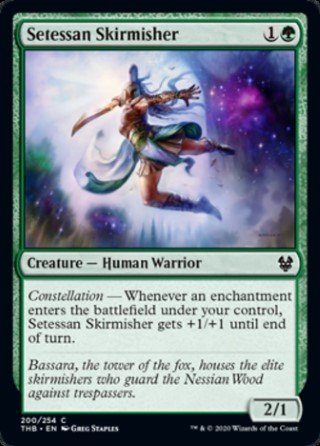
Setessan Skirmisher
AI Rating: 1.6Pro Rating: 2.5
This is a two-drop that is often a 4/3, and that’s not too shabby. It is an especially good place to stick an Aura, as the boost it will get on the turn you play it will be awesome.
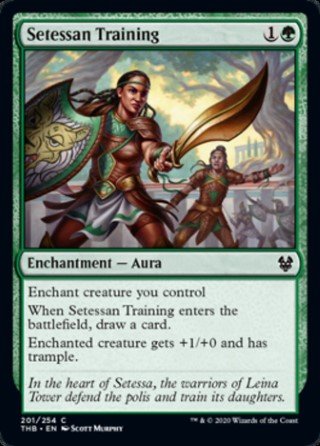
Setessan Training
AI Rating: 2.3Pro Rating: 2.5
This replaces itself, and that’s quite nice. The +1/+0 and Trample boost probably wouldn’t have been enough, even in a format with Enchantmetn synergy, but because it draws you a card, you get to avoid the danger of a 2-for-1.
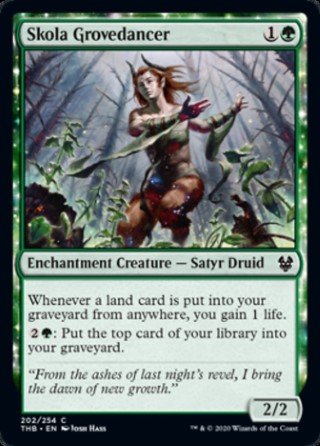
Skola Grovedancer
AI Rating: 1.8Pro Rating: 2.0
This is a decent enough two-drop. None of its text is especially impressive, but at least it has a man sink ability that can help fuel your Escape.
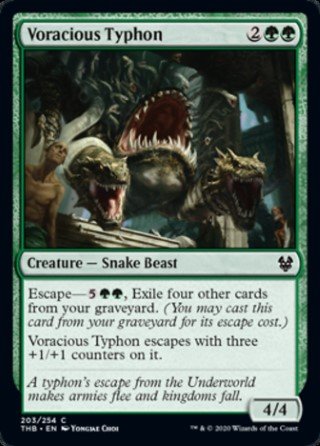
Voracious Typhon
AI Rating: 3.5Pro Rating: 4.0
This is an excellent common. A 4-mana 4/4 virtually always makes the cut, but this one gets to come back in the late game much larger, guaranteeing you a 2-for-1, and sometimes just being a straight up win condition.
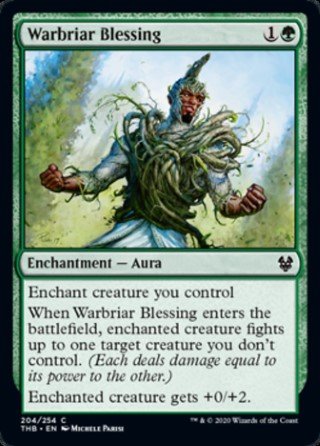
Warbriar Blessing
AI Rating: 3.5Pro Rating: 3.5
This gives a large enough boost to toughness that this enables a number of creatures to fight and survive than would have been able to without it. This often feels like a removal spell that leaves behind a permanent stats boost for one of your creatures, and that tends to feel pretty good – though it does have the usual downsides that Fight spells do – if you’re not careful, you might get 2-for-1’d.

Wolfwillow Haven
AI Rating: 3.1Pro Rating: 3.0
This gives you a nice mana boost in the early game, and then in the late game – when such an effect doesn’t feel especially useful – it gives you something that can actually impact the board in the form of a wolf token.
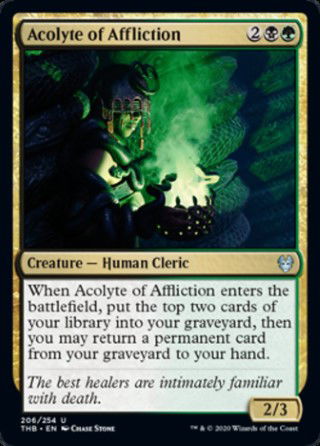
Acolyte of Affliction
AI Rating: 2.5Pro Rating: 4.0
This loads your graveyard for you while also returning a permanent, and that effect feels pretty great in a format with lots of graveyard antics. It has reasonable enough stats to represent a 2-for-1, too.
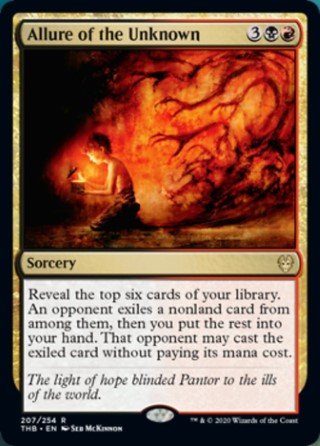
Allure of the Unknown
AI Rating: 4.6Pro Rating: 1.0
5 mana to draw 5 is obviously insane -- but the downside here is pretty real. Letting your opponent cast whatever the best card among the six you reveal -- and letting them cast it for free – can be brutal. I think this will work out well for you more often than it won’t, but the significant times where it just loses you the game makes me unwilling to run it most of the time.
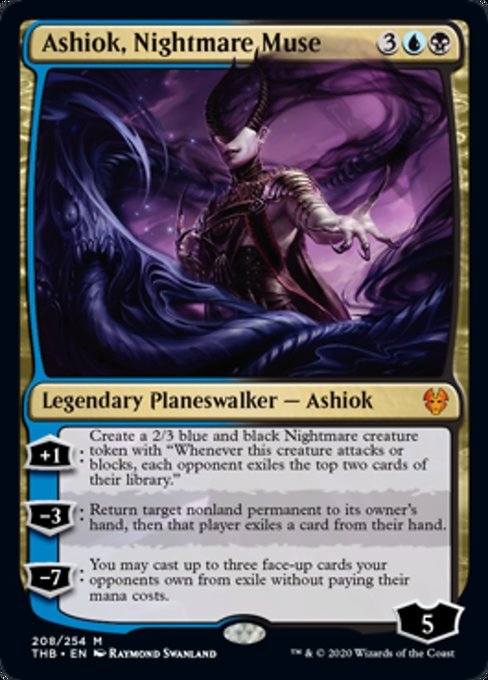
Ashiok, Nightmare Muse
AI Rating: 5Pro Rating: 5.0
5 for 5 loyalty is usually a good place to be, and Ashiok can immediately go up to 6 loyalty and make a 2/3!(!) creature, which also happens to start exiling stuff from your opponent’s library. That last part probably won’t matter a ton, but in a format that has a graveyard theme, it could turn out to be pretty nice. So, Ashiok, Nightmare Muse can use the ⅔ to protect them, and also just start filling the baord with them. Ashiok’s -3 ability is quite good too -- allowing you to bounce something and make your opponent discard a card from their hand is great, and it will be particularly spicy in situations where your opponent has no hand. Ashiok’s ultimate is also the kind that can just end games, though it does require some set up. So -- Ashiok can add pretty nice creatures to the board, bounce problem permanents, and has a game-breaking ultimate -- that makes Ashiok an absolute bomb.
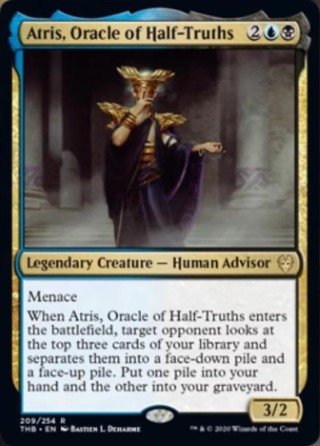
Atris, Oracle of Half-Truths
AI Rating: 5Pro Rating: 4.0
So, at worst, this is a 4-mana 3/2 with Menace that draws you a card. Thing is, your opponent always has to make two piles, and that means one of them will always have two cards, and more often than not it will be correct to grab the two cards. Atris will actually create a fun little battle of wits, where your opponent tries to decide whether or not it is best to put the best card alone in one pile, and the two lesser cards in the other pile -- or if they try to psych you out one way or another. But, no matter what, Atris will net you one card, and sometimes more -- while also helping stock your gravreyard. Sure, a 4-mana 3/2 with Menace isn’t going to be surviving attacking a whole lot, but that’s ok, since you’ll usually still be able to get a 2-for-1.

Bronzehide Lion
AI Rating: 4.9Pro Rating: 4.0
This feels great on turn two, and the fact that when it dies it turns into Aura that can grant indestructibility means you’re virtually always going to get some value out of it.

Calix, Destiny's Hand
AI Rating: 4.5Pro Rating: 4.0
So, Calix loves Enchantments. And in a format with a bunch of Enchantments, I think he will be pretty powerful – his +1 will regularly draw you a card, and his -3 will let you kill anything that stands in your way. He doesn’t have an Ultimate that will be consistently game-breaking, but it isn’t bad. Now, this set is loaded up with Enchantments for sure, but I think you need around 7 of them for Calix to be at his best, and sometimes even in a deck with that many he won’t be at his best.

Dalakos, Crafter of Wonders
AI Rating: 4.3Pro Rating: 2.5
This is an interesting inclusion in this set, mostly because this set does not have a lot of Artifacts or Equipment, and those are the things he helps you out with. The good news is, he is a 3-mana 2/4, which is actually pretty decent on the Vanilla test. Sure, he costs both Blue and Red, but if you’re in a UR deck and you have even one piece of Equipment, he’s probably going to be worth running because that upside is pretty real.
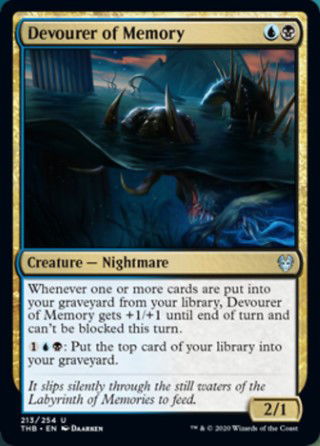
Devourer of Memory
AI Rating: 2.2Pro Rating: 3.5
As a two mana 2/1, it doesn’t do so well on the vanilla test, but this set is loaded up with self-mill cards, especially in Blue and Black, and that will make it a 3/2 unblockable on your turn a lot of the time, especially because it comes with a built-in way to start milling yourself, which is not a bad place to sink mana in the later part of the game. The Devourer can represent some serious inevitability, and I am definitely interested in that.
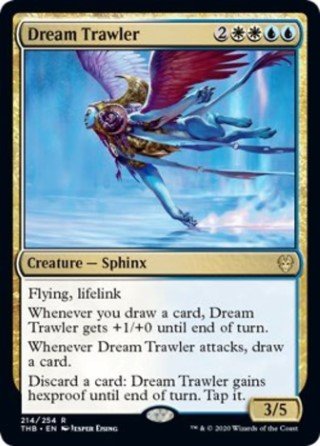
Dream Trawler
AI Rating: 5Pro Rating: 5.0
This is the biggest bomb in the set, and one of the most unbeatable bombs in the history of Magic! As long as you make sure to hold on to a card when you play the Trawler, it is highly unlikely your opponent will be able to deal with it in Limited. On your turn, it will amount to – at worst – a 4/5 with flying and Lifelink, and those are the stats of a very real win condition already! But yeah, it also nets you cards, so holding on to ways to make it hexproof and protect it won’t be very difficult!
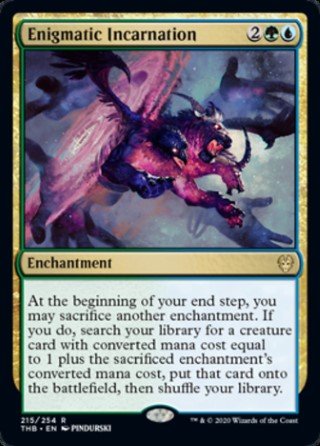
Enigmatic Incarnation
AI Rating: 4.5Pro Rating: 0.0
This is too situational and difficult to build around to be worth it in Limited.

Eutropia the Twice-Favored
AI Rating: 3.2Pro Rating: 4.0
Eutropia is a great payoff for Enchantments. If she could just put counters on things or just give them flying, she would be a good card – but she does both! Keep in mind too, that even if you have nothing on board, Eutropia can pump herself.
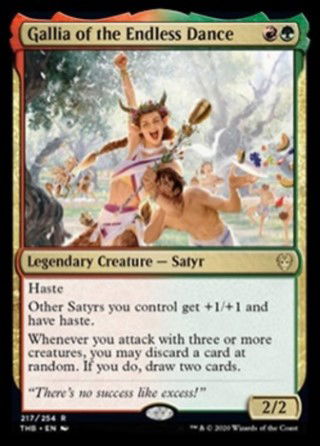
Gallia of the Endless Dance
AI Rating: 4.8Pro Rating: 3.0
A two mana 2/2 with Haste that might pump some of the creatures in your deck wouldn’t be that exciting most of the time -- but if your deck is aggressive, the ability to discard a random card and draw two is super powerful. It is the kind of thing that can keep a really aggressive deck from running out of steam, as they sometimes can. Note, by the way, that Gallia doesn’t need to do the attacking for that effect to happen -- it can be any three creatures, so you can keep her back so you can continue to get value out of the ability, instead of her dying in combat.
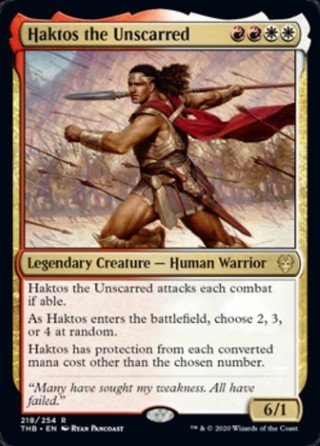
Haktos the Unscarred
AI Rating: 4.6Pro Rating: 4.0
This 4-mana 6/1 is not easy to deal with or interact with. This is because his random ability will usually make it challenging for more than one creature to block, and sometimes he will just be straight unblockable. Worth noting that he can even blank removal spells thanks to his random ability! Now, because he is random, there will be times where he isn’t able to do a whole lot, but it seems like most fail cases will still involve him being able to attack and trade with something.
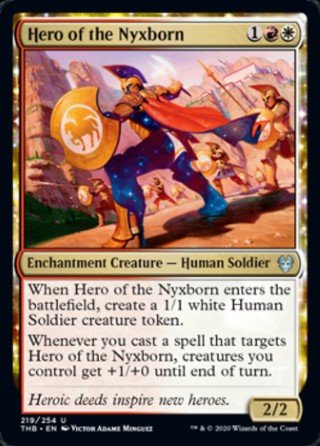
Hero of the Nyxborn
AI Rating: 1.9Pro Rating: 3.5
This gives you a 2/2 and a 1/1 for three mana, and then pays you off for going wide with its “Heroic” trigger. That’s a pretty good deal overall, especially in a deck going wide.
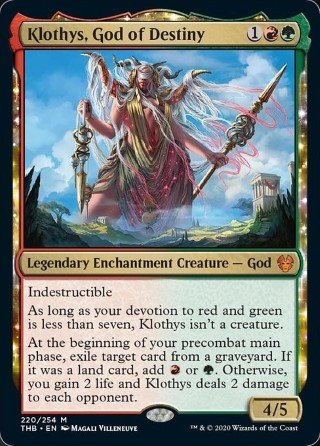
Klothys, God of Destiny
AI Rating: 5Pro Rating: 4.0
Klothys does some very powerful things. This set has lots of graveyard stuff going on, so both your graveyard and your opponent’s will often have creatures in it, and Klothys gives you some great value when that is the case, either ramping you or draining the opponent for two. Klothys makes it a challenge for your opponent to race you, while also helping you ramp. Sometimes, in a set with escape, Klothys doesn’t have quite as much fuel as you would like, but overall is still a very good card.
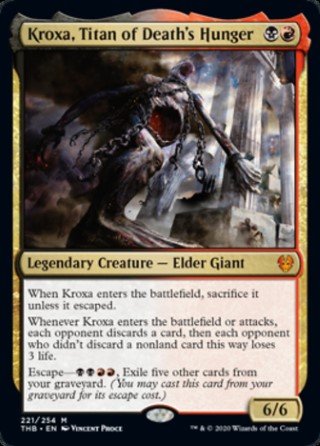
Kroxa, Titan of Death's Hunger
AI Rating: 4.8Pro Rating: 4.5
In the early game, this will effectively be a discard spell, and then in the later part of the game, Kroxa gets to Escape from the graveyard and come back as a huge creature who triggers that discard spell when it comes into play, and then again any time it attacks. One nice thing about the discard effect is it punishes your opponent if they don’t discard a nonland, and they often won’t want too, but that damage can really add up once Kroxa sticks around on the board.

Kunoros, Hound of Athreos
AI Rating: 5Pro Rating: 3.5
People often over-estimate this kind of card in Limited. A recent similar example was Questing Beast -- a super efficient creature with a brick full of text, but one that isn’t imposing enough to really be considered a bomb, since it can be blocked without a whole lot of effort. Now, don’t get me wrong, Questing Beast was excellent and you took it almost any time you saw it -- but it was nowhere near a bomb, since Limited often has very cluttered board states, and it frequently just didn’t do anything. Now, Kumoros does come with an evasive ability in Menace, as well as having Lifelink and Vigilance, and that’s all pretty nice together -- but he’ll have the same problem, there will be lots of board states where it just can’t attack effectively. It does come with some useful hate abilities that will certainly come up in this format too!
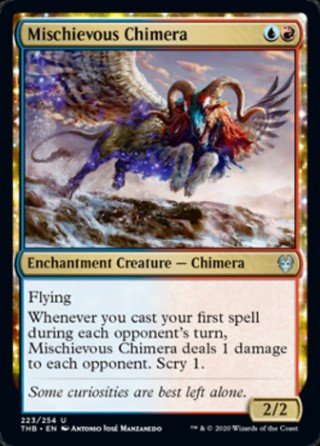
Mischievous Chimera
AI Rating: 1.6Pro Rating: 3.0
This isn’t the greatest of signpost uncommons, and I think it is a big reason why UR decks fall flat sometimes. Don’t get me wrong, it has good evasive stats and a nice ability – doing 1 to the opponent and scrying when you cast a spell on their turn is nice! I’m just saying it doesn’t feel quite as pushed as the other signposts in this set.

Polukranos, Unchained
AI Rating: 5Pro Rating: 5.0
Well, Polukranos is Back, and he is undead and super powerful. A 4-mana 6/6 is already greatand while Poukranos does have an ability that is mostly a downside -- preventing damage and removing that many +1/+1 counters -- he comes with enough additional upside that you shouldn’t really care. His ability to fight anything means he can kill multiple creatures if he can stay in play, and he can Escape later in the game, and come back as a 12/12, which will allow him to fight a lot more things!
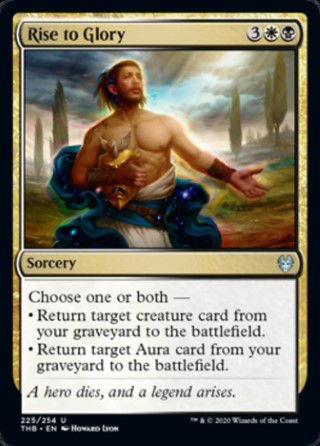
Rise to Glory
AI Rating: 3.1Pro Rating: 3.5
So, this can get pretty silly when you can get a graveyard to have both an Aura and a creature, and that isn’t that hard to do in this format. You will pretty much always get more than 5 mana worth of value when you do it, and it gets especially silly with Constellation and bombs. This can help you get back ahead from behind, which is awesome! The trade off is that it can be pretty terrible early, though.
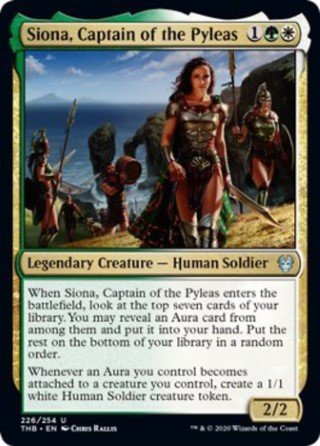
Siona, Captain of the Pyleas
AI Rating: 3.2Pro Rating: 3.5
Siona makes it clear that GW is all about Enchantments, and more specifically - Auras. It is going to be pretty hard to wiff entirely on Enchantments in your top 7 cards in this format, so generally Siona will at least be a 3-mana 2/2 that draws you a card, something that is always solid. But then, it comes with the ability to make a creature token every time you put an Aura on one of your creatures, and that’s a nice payoff too. Auras can sometimes be risky because if your opponent has removal, you get 2-for-1’d -- but making a creature token every time you put an Aura on something helps soften the blow if that’s what happens, because at least you have a 1/1 left behind. Siona is going to draw you a card and make 1-2 creature tokens without a whole lot of help.
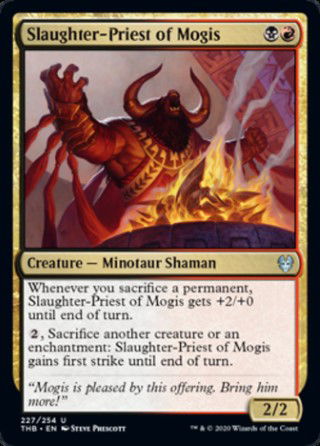
Slaughter-Priest of Mogis
AI Rating: 2.7Pro Rating: 3.5
This is a nice payoff for Sacrifing and a sacrifice outlet itself! I always like when payoffs can synergize with themselves, as that makes them a lot less risky. This is a very difficult creature to block, and at the same time sometimes you can’t just take it because it can kill you. That makes him a challenging thing to face down.

Staggering Insight
AI Rating: 4Pro Rating: 3.5
I like this a lot, especially the idea of putting it on an evasive creature. Auras can be super risky because of 2-for-1s, but any Aura that can help mitigate against that is going to be nice, and this certainly does that -- drawing you a card every single time your creature hits your opponent. As long as your deck has a reasonable number of flyers -- and it will in UW -- there are going to be times where you just stick this on a flier and run away with the game. Putting it on a creature on the ground makes it harder to get the full value out of it, but it can still present a real threat.
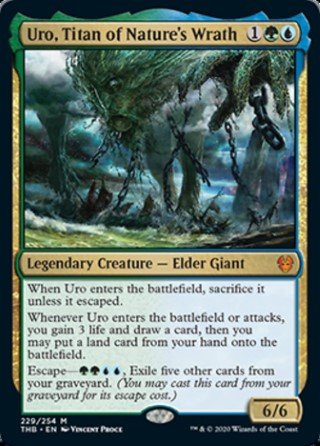
Uro, Titan of Nature's Wrath
AI Rating: 4.7Pro Rating: 5.0
So, if it doesn’t escape, you basically have a three mana spell that gains you 3 life, draws you a card, and puts a land on to the battlefield. That is already pretty close to a playable card. Then, when this escapes, it gets to be completely absurd -- amounting to a 4-mana 6/6 that will then draw you a card, gain you 3 life, and let you play a land etc., And, true to the “Titan” in its name, then it does it all again every time it attacks! The escape does require double-colored mana, and asks for five other cards in your graveyard, and both of those things are far from completely guaranteed, but it is easier to accomplish than you might think. If Uro escapes, you probably win the game.

Warden of the Chained
AI Rating: 2.8Pro Rating: 3.0
This signpost uncommon feels a bit underwhelming to me. Sure, the guy is efficient and he has trample, but I feel like I should be getting a little something else to make up for the downside here. Sure, even if you don’t have a big enough creature, the Warden is a good blocker, and sure – RG is the color pair all about having high power – but still, just not that impressed here. Will you play him in all your RG decks? Absolutely. But he shouldn’t be the card that pulls you into the color pair.
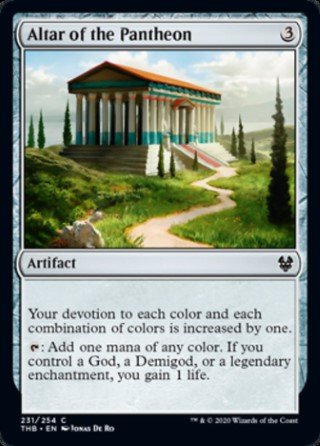
Altar of the Pantheon
AI Rating: 2.1Pro Rating: 1.5
Devotion is a much smaller theme in Theros this time around, but there are a few cards that care about it. This also fixes and ramps for you, which some decks will want, and it will even gain you life on occasion, which doesn’t hurt!
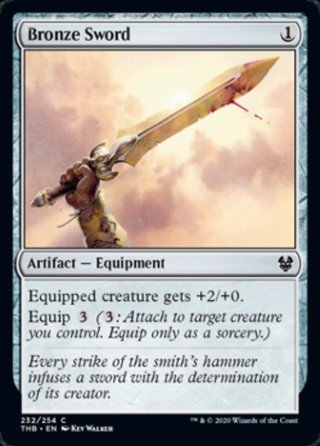
Bronze Sword
AI Rating: 0.4Pro Rating: 1.0
1 to play and 3 to equip is too much for this stats boost in most cases.
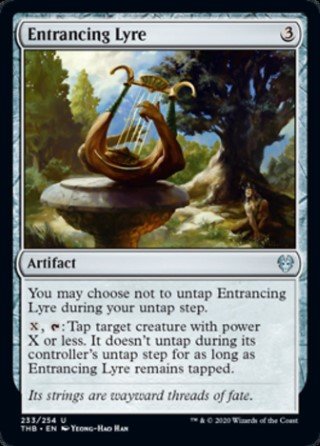
Entrancing Lyre
AI Rating: 3.7Pro Rating: 3.5
This basically amounts to being colorless removal – and colorless removal that is pretty darn flexible! You can use this to lock down an opposing creature, and keep it locked down as long as you want – but once something more problematic shows up, you can shift the Lyre to locking that creature down. This might sound mostly defensive, but you can also use this quite offensively – like tap something on your opponents end step, and then again on your turn, and suddenly your opponent has no blockers!
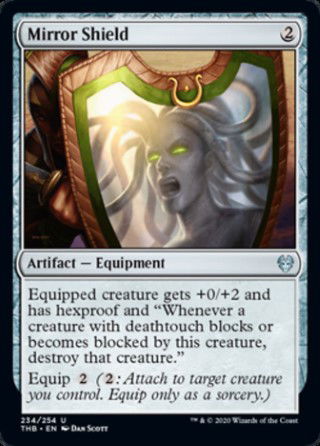
Mirror Shield
AI Rating: 1.5Pro Rating: 0.5
People tend to really overrate equipment that grants Hexproof and doesn’t do much else. The main problem is that you already need your creature to be good for Mirror Shield to matter, and the best equipment helps make any creature good. As it is, Mirror Shield just isn’t worth it. You probably only run this if you have Dalakos.
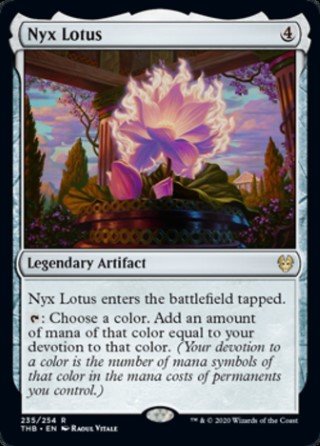
Nyx Lotus
AI Rating: 4.8Pro Rating: 1.0
This is interesting, but I think that most of the time, you won’t want to play this in Limited. This is because it is only good if you have two things going on -- one of them is that you have stuff worth ramping into or mana sinks, and the other is that you are really heavy in one particular color. It is nice that you can choose between colors to maximize the mana it gives you, but mana ramp like this usually only has very narrow uses in Limited.
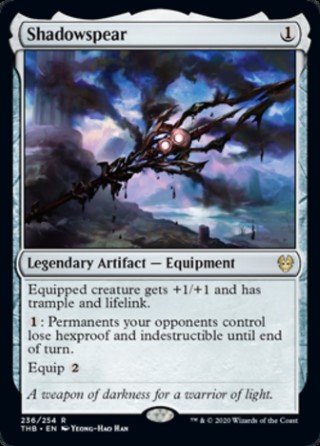
Shadowspear
AI Rating: 5Pro Rating: 4.5
This is a great efficient piece of Equipment that makes just about any creature into a problem. Lifelink is always a nightmare to play against, especially when your opponent can just keep a card on the table that can give life link to anything! Meanwhile, trample suddenly makes your big dumb guys a lot harder for your opponent to stop. Believe it or not, the turn of hexproof and indestructible part of the card will actually come up every now and again too, which is hilarious, because most people forget about that part of the card when you play against it.

Soul-Guide Lantern
AI Rating: 1.4Pro Rating: 1.5
This format has a lot of graveyard stuff, so this is a little better than it usually is. Worst case, it can sort of just cycle itself, best case, it really interferes with your opponents’ plans.
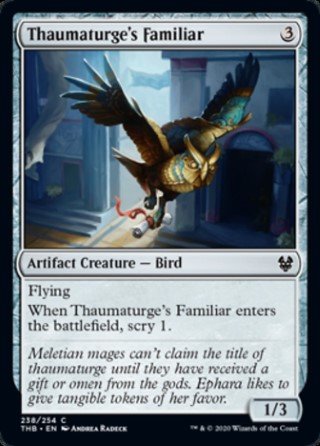
Thaumaturge's Familiar
AI Rating: 0.7Pro Rating: 1.0
This has bad stats for the cost, and Scry doesn’t really change that.
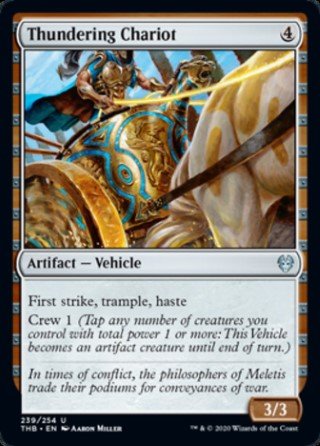
Thundering Chariot
AI Rating: 1.9Pro Rating: 2.5
This is pretty easy to crew, but not that easy to cast. It is a pretty good creature though when you can crew it.
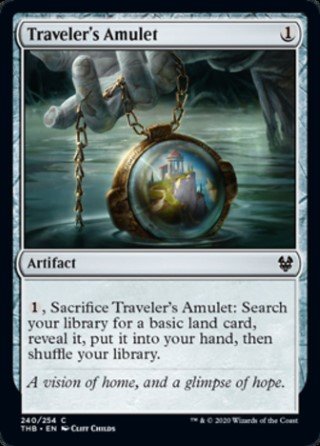
Traveler's Amulet
AI Rating: 1.8Pro Rating: 2.5
This is always nice in every format we see it in. It gives you serious fixing, and if your curve is low enough you can count it as a land in your deck, allowing you to play more meaningful cards.
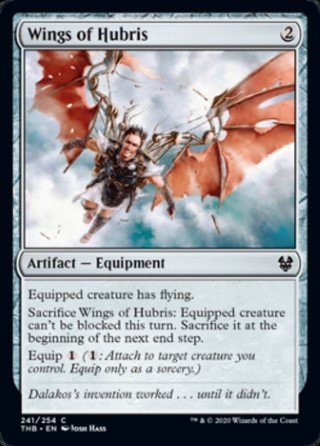
Wings of Hubris
AI Rating: 0.7Pro Rating: 1.5
Granting flying to things is always a reasonable thing to do with Equipment, and the additional upside here of making the equipped creature unblockable doesn’t hurt, though you probably only do that if you can do lethal.
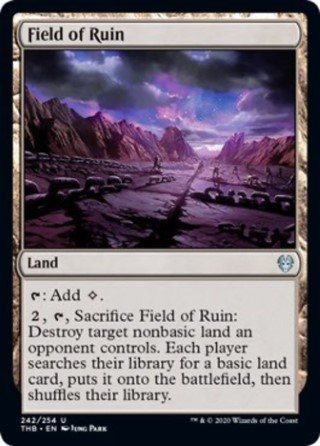
Field of Ruin
AI Rating: 0.5Pro Rating: 0.0
This is unplayable, as usual. There aren’t enough non-basics in this set for it to be worth running. If there were, it would actually be kind of interesting -- since it can also fix for you, but if it doesn’t’ have a target, it is just a land that produces only colorless mana, and that’s liability in Limited, where mana bases usually aren’t very good to begin with.
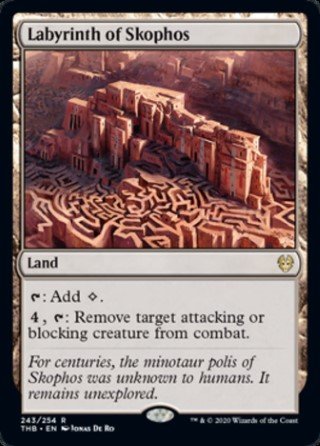
Labyrinth of Skophos
AI Rating: 5Pro Rating: 3.0
This is a nice utility land. Any land that becomes a meaningful card at some point in a game feels nice, since most lands have outlived their usefulness by that point of the game. This can really make it hard for your opponent to attack you, especially.
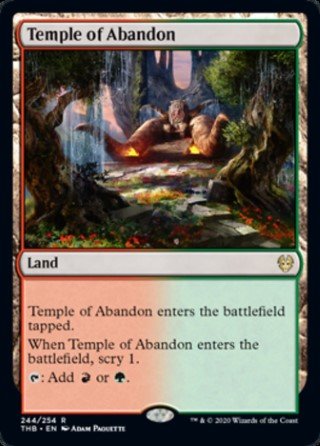
Temple of Abandon
AI Rating: 4.9Pro Rating: 3.0
These give great fixing while also improving your draw a little bit. That makes it well worth the fact it comes into play tapped.
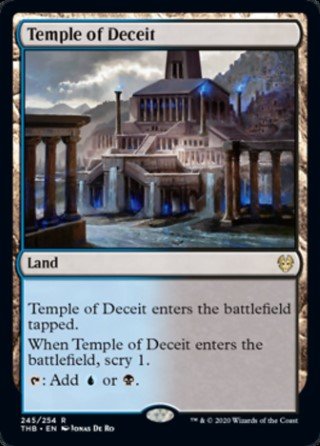
Temple of Deceit
AI Rating: 5Pro Rating: 3.0
These give great fixing while also improving your draw a little bit. That makes it well worth the fact it comes into play tapped.

Temple of Enlightenment
AI Rating: 5Pro Rating: 3.0
These give great fixing while also improving your draw a little bit. That makes it well worth the fact it comes into play tapped.
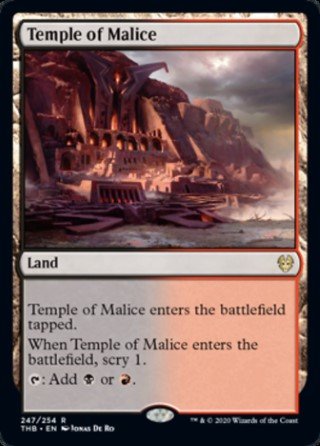
Temple of Malice
AI Rating: 5Pro Rating: 3.0
These give great fixing while also improving your draw a little bit. That makes it well worth the fact it comes into play tapped.
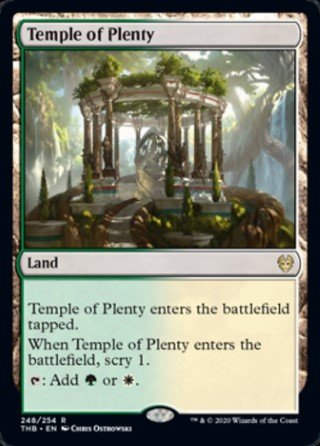
Temple of Plenty
AI Rating: 5Pro Rating: 3.0
These give great fixing while also improving your draw a little bit. That makes it well worth the fact it comes into play tapped.

Unknown Shores
AI Rating: 0.8Pro Rating: 1.0
Filterlands that don’t do anything else tend to be pretty bad, but you’ll run this if you’re desperate for fixing.
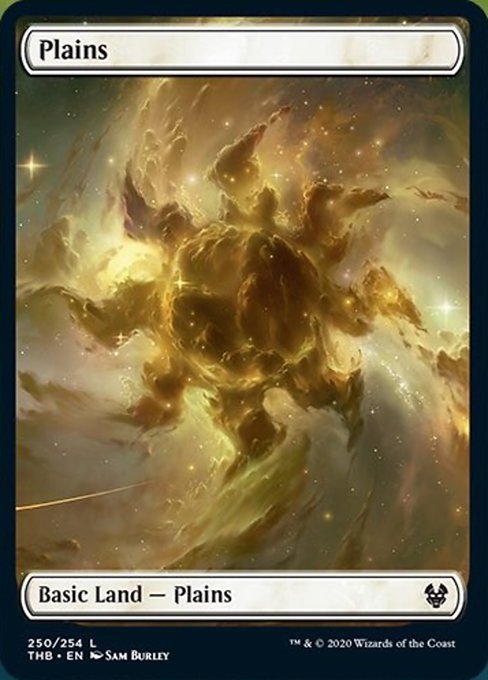
Plains
AI Rating: -0Pro Rating:

Island
AI Rating: -0Pro Rating:
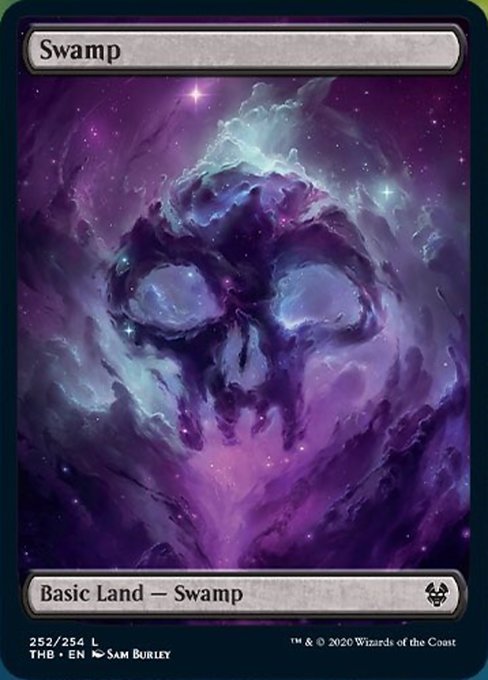
Swamp
AI Rating: -0Pro Rating:
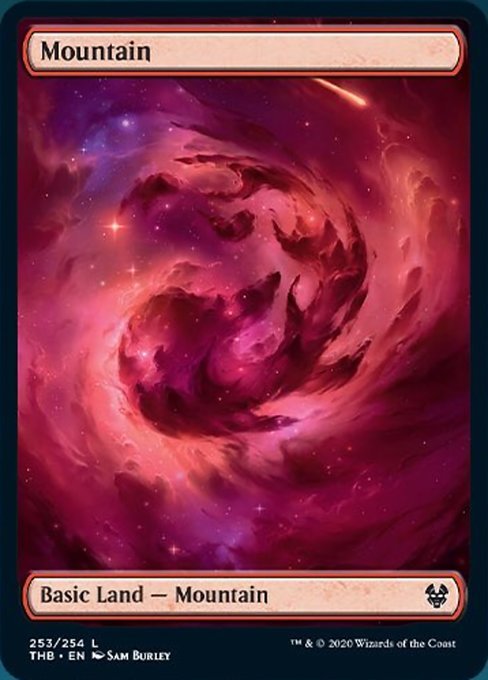
Mountain
AI Rating: -0Pro Rating:
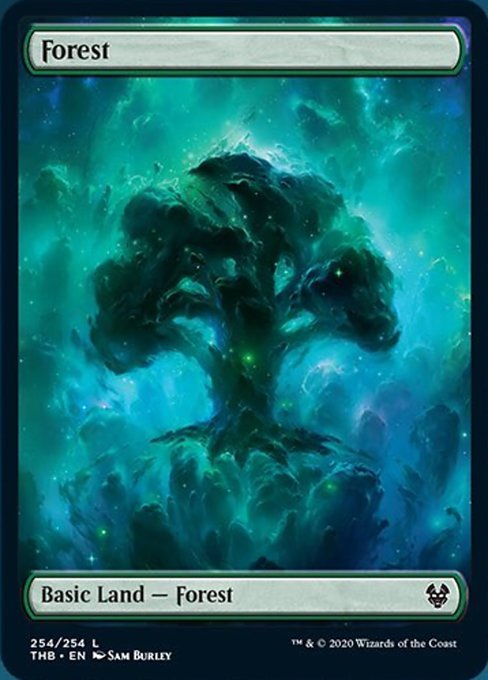
Forest
AI Rating: -0Pro Rating:
| Card | Pro Rating | AI Rating | APA | Picked | ALSA | Seen |
|---|---|---|---|---|---|---|
|
ss-uncommon|White|Enchantment Creature — Nymph
|
3.0 | 3.7 | 4.32 | 19 | 3.16 | 66 |
|
ss-uncommon|White|Creature — Archon
|
3.0 | 4.1 | 3.16 | 251 | 2.70 | 849 |
|
ss-rare|White|Creature — Archon
|
5.0 | 5 | 1.00 | 136 | 1.00 | 149 |
|
ss-uncommon|White|Enchantment
|
5.0 | 4.4 | 2.32 | 332 | 2.14 | 680 |
|
ss-uncommon|White|Enchantment — Saga
|
2.5 | 3.4 | 5.00 | 19 | 4.35 | 73 |
|
ss-common text-light|White|Creature — Unicorn
|
1.5 | 1.4 | 9.89 | 28 | 7.65 | 333 |
|
ss-uncommon|White|Enchantment — Aura
|
3.0 | 4 | 3.23 | 448 | 2.98 | 992 |
|
ss-uncommon|White|Enchantment Creature — Human Cleric
|
2.5 | 3.2 | 5.38 | 13 | 4.20 | 86 |
|
ss-uncommon|White|Legendary Enchantment Creature — Demigod
|
3.0 | 3.8 | 3.88 | 349 | 3.49 | 1132 |
|
ss-common text-light|White|Creature — Chimera
|
3.0 | 3.1 | 5.66 | 56 | 5.02 | 236 |
|
ss-common text-light|White|Enchantment — Aura
|
3.5 | 3.7 | 4.10 | 51 | 3.77 | 169 |
|
ss-rare|White|Enchantment Creature — Spirit
|
3.0 | 4.6 | 1.97 | 58 | 1.71 | 175 |
|
ss-rare|White|Enchantment — Saga
|
5.0 | 5 | 1.00 | 103 | 1.00 | 120 |
|
ss-mythic|White|Legendary Planeswalker — Elspeth
|
4.5 | 4.9 | 1.25 | 4 | 1.25 | 4 |
|
ss-uncommon|White|Creature — Human Soldier
|
2.5 | 3.2 | 5.13 | 321 | 4.39 | 1400 |
|
ss-common text-light|White|Instant
|
1.0 | 1.4 | 9.87 | 38 | 8.78 | 426 |
|
ss-common text-light|White|Enchantment Creature — Human Cleric
|
1.5 | 1.4 | 9.90 | 40 | 7.95 | 402 |
|
ss-mythic|White|Legendary Enchantment Creature — God
|
4.5 | 4.9 | 1.25 | 8 | 1.42 | 12 |
|
ss-rare|White|Instant
|
4.0 | 4.7 | 1.61 | 90 | 1.66 | 161 |
|
ss-common text-light|White|Creature — Human Cleric
|
3.0 | 3.2 | 5.36 | 64 | 5.18 | 277 |
|
ss-uncommon|White|Enchantment — Aura
|
3.5 | 3.1 | 5.71 | 17 | 4.13 | 98 |
|
ss-common text-light|White|Creature — Cat Soldier
|
2.0 | 2.4 | 7.35 | 40 | 6.64 | 302 |
|
ss-uncommon|White|Creature — Human Soldier
|
2.0 | 2.1 | 8.25 | 12 | 5.51 | 111 |
|
ss-rare|White|Sorcery
|
0.5 | 4.6 | 1.87 | 38 | 1.86 | 201 |
|
ss-common text-light|White|Enchantment — Aura
|
1.5 | 2.2 | 7.87 | 39 | 7.03 | 319 |
|
ss-common text-light|White|Instant
|
1.5 | 2.1 | 8.17 | 47 | 7.43 | 346 |
|
ss-uncommon|White|Creature — Centaur Advisor
|
2.5 | 3.2 | 5.36 | 22 | 4.12 | 66 |
|
ss-common text-light|White|Creature — Cat Warrior
|
2.0 | 2 | 8.32 | 50 | 7.72 | 382 |
|
ss-common text-light|White|Enchantment Creature — Centaur Scout
|
1.0 | 1.7 | 9.03 | 36 | 7.98 | 397 |
|
ss-common text-light|White|Enchantment
|
2.0 | 3.5 | 4.66 | 41 | 4.81 | 234 |
|
ss-uncommon|White|Instant
|
2.0 | 3 | 5.87 | 15 | 5.69 | 129 |
|
ss-common text-light|White|Creature — Human Scout
|
2.5 | 2.4 | 7.50 | 38 | 6.76 | 312 |
|
ss-uncommon|White|Creature — Human Soldier
|
2.5 | 3.3 | 5.32 | 19 | 4.81 | 85 |
|
ss-common text-light|White|Sorcery
|
2.5 | 2.4 | 7.48 | 56 | 7.09 | 316 |
|
ss-common text-light|White|Creature — Giant
|
1.5 | 0.6 | 11.76 | 38 | 9.50 | 452 |
|
ss-common text-light|White|Enchantment — Aura
|
2.5 | 2.4 | 7.31 | 42 | 6.18 | 276 |
|
ss-rare|White|Sorcery
|
4.5 | 5 | 1.00 | 65 | 1.00 | 102 |
|
ss-common text-light|White|Creature — Pegasus
|
3.0 | 2.5 | 7.20 | 55 | 6.59 | 295 |
|
ss-rare|White|Legendary Creature — Human Soldier
|
3.5 | 5 | 1.00 | 74 | 1.00 | 104 |
|
ss-common text-light|White|Enchantment Creature — Griffin
|
2.5 | 2.8 | 6.35 | 43 | 5.98 | 289 |
|
ss-common text-light|White|Instant
|
1.5 | 1.9 | 8.73 | 41 | 7.43 | 329 |
|
ss-uncommon|Blue|Legendary Creature — Human
|
4.0 | 4.1 | 3.22 | 23 | 2.88 | 63 |
|
ss-rare|Blue|Enchantment
|
0.0 | 4.5 | 2.26 | 27 | 2.09 | 196 |
|
ss-common text-light|Blue|Creature — Giant
|
1.5 | 1.8 | 9.00 | 26 | 7.36 | 344 |
|
ss-uncommon|Blue|Legendary Enchantment Creature — Demigod
|
2.5 | 4 | 3.55 | 11 | 3.60 | 77 |
|
ss-common text-light|Blue|Instant
|
1.0 | 0.4 | 12.30 | 23 | 10.05 | 498 |
|
ss-common text-light|Blue|Instant
|
2.5 | 1.6 | 9.40 | 30 | 7.50 | 358 |
|
ss-common text-light|Blue|Enchantment Creature — Spirit
|
1.5 | 0.9 | 11.06 | 31 | 9.01 | 441 |
|
ss-common text-light|Blue|Creature — Human Wizard
|
1.5 | 0.9 | 11.09 | 35 | 9.38 | 463 |
|
ss-uncommon|Blue|Instant
|
1.5 | 1.3 | 10.17 | 12 | 7.45 | 138 |
|
ss-common text-light|Blue|Enchantment — Aura
|
2.5 | 2 | 8.31 | 29 | 6.50 | 284 |
|
ss-mythic|Blue|Enchantment — Saga
|
5.0 | 5 | 1.00 | 66 | 1.00 | 72 |
|
ss-uncommon|Blue|Enchantment — Saga
|
2.5 | 4.2 | 2.95 | 99 | 2.56 | 793 |
|
ss-common text-light|Blue|Instant
|
0.5 | 0.5 | 12.07 | 29 | 9.28 | 469 |
|
ss-rare|Blue|Creature — Kraken
|
4.5 | 5 | 1.00 | 68 | 1.00 | 99 |
|
ss-common text-light|Blue|Enchantment Creature — Nymph
|
2.5 | 1.9 | 8.75 | 32 | 7.58 | 338 |
|
ss-common text-light|Blue|Enchantment Creature — Merfolk Soldier
|
1.5 | 0.2 | 12.73 | 30 | 9.86 | 437 |
|
ss-common text-light|Blue|Enchantment
|
2.5 | 3.1 | 5.77 | 31 | 5.42 | 238 |
|
ss-uncommon|Blue|Enchantment — Aura
|
2.5 | 2.7 | 6.61 | 18 | 5.23 | 96 |
|
ss-rare|Blue|Creature — Human Wizard
|
3.0 | 4.6 | 1.85 | 91 | 1.98 | 224 |
|
ss-common text-light|Blue|Creature — Turtle
|
1.0 | 0.9 | 11.05 | 19 | 9.12 | 443 |
|
ss-uncommon|Blue|Creature — Human Wizard
|
1.0 | 0.8 | 11.29 | 7 | 6.43 | 116 |
|
ss-uncommon|Blue|Sorcery
|
1.5 | 1.6 | 9.50 | 8 | 6.45 | 138 |
|
ss-uncommon|Blue|Enchantment Creature — Chimera
|
3.5 | 4.2 | 2.76 | 194 | 2.39 | 658 |
|
ss-uncommon|Blue|Creature — Kraken
|
2.0 | 2.1 | 8.20 | 10 | 5.58 | 92 |
|
ss-common text-light|Blue|Sorcery
|
1.5 | 0.4 | 12.44 | 32 | 10.17 | 527 |
|
ss-common text-light|Blue|Enchantment — Aura
|
2.0 | 1.7 | 9.03 | 34 | 7.08 | 337 |
|
ss-common text-light|Blue|Instant
|
2.5 | 1.2 | 10.32 | 44 | 8.60 | 434 |
|
ss-uncommon|Blue|Enchantment Creature — Fish
|
2.0 | 3.4 | 5.00 | 5 | 4.82 | 85 |
|
ss-uncommon|Blue|Sorcery
|
0.5 | -0 | 13.33 | 6 | 8.23 | 175 |
|
ss-mythic|Blue|Legendary Enchantment Creature — God
|
4.0 | 4.8 | 1.40 | 5 | 1.25 | 8 |
|
ss-rare|Blue|Instant
|
2.5 | 4.7 | 1.75 | 71 | 1.74 | 157 |
|
ss-rare|Blue|Creature — Merfolk Wizard
|
2.5 | 4.4 | 2.34 | 47 | 1.98 | 187 |
|
ss-common text-light|Blue|Instant
|
2.5 | 1.8 | 9.00 | 28 | 7.08 | 314 |
|
ss-uncommon|Blue|Creature — Siren
|
3.0 | 3.1 | 5.64 | 14 | 3.83 | 78 |
|
ss-rare|Blue|Legendary Creature — Elemental Giant
|
4.5 | 5 | 1.00 | 68 | 1.00 | 105 |
|
ss-common text-light|Blue|Creature — Merfolk Wizard
|
2.0 | 0.7 | 11.61 | 28 | 9.04 | 429 |
|
ss-common text-light|Blue|Creature — Merfolk Wizard
|
2.0 | 0.9 | 11.07 | 43 | 9.08 | 438 |
|
ss-common text-light|Blue|Creature — Bird
|
2.5 | 2.3 | 7.72 | 43 | 7.61 | 329 |
|
ss-rare|Blue|Enchantment Creature — Horse Fish
|
1.0 // 3.5 | 5 | 1.00 | 29 | 1.00 | 105 |
|
ss-uncommon|Blue|Instant
|
1.5 | 1.9 | 8.75 | 8 | 6.62 | 128 |
|
ss-common text-light|Blue|Enchantment Creature — Sphinx
|
2.5 | 2.7 | 6.69 | 35 | 5.90 | 278 |
|
ss-uncommon|Black|Sorcery
|
3.0 | 3 | 5.93 | 15 | 4.95 | 99 |
|
ss-rare|Black|Legendary Enchantment Creature — Harpy
|
4.0 | 5 | 1.09 | 70 | 1.08 | 108 |
|
ss-common text-light|Black|Enchantment — Aura
|
2.0 | 1.8 | 8.88 | 42 | 7.39 | 343 |
|
ss-common text-light|Black|Creature — Beast
|
3.0 | 2.8 | 6.38 | 58 | 5.98 | 273 |
|
ss-uncommon|Black|Instant
|
0.0 | 1.6 | 9.40 | 10 | 6.06 | 113 |
|
ss-common text-light|Black|Creature — Zombie Satyr
|
2.5 | 2.3 | 7.66 | 58 | 7.65 | 373 |
|
ss-uncommon|Black|Instant
|
4.0 | 4.4 | 2.48 | 250 | 2.23 | 655 |
|
ss-rare|Black|Instant
|
4.0 | 5 | 1.07 | 86 | 1.06 | 110 |
|
ss-uncommon|Black|Enchantment — Saga
|
3.5 | 4.1 | 3.18 | 372 | 3.09 | 857 |
|
ss-uncommon|Black|Enchantment Creature — Demon
|
1.5 | 2.9 | 6.14 | 14 | 4.91 | 87 |
|
ss-mythic|Black|Legendary Enchantment Creature — God
|
4.0 | 5 | 1.00 | 3 | 1.20 | 5 |
|
ss-rare|Black|Instant
|
4.0 | 5 | 1.00 | 75 | 1.00 | 122 |
|
ss-common text-light|Black|Instant
|
3.0 | 3.6 | 4.47 | 55 | 4.22 | 190 |
|
ss-common text-light|Black|Sorcery
|
0.0 | 0.2 | 12.85 | 40 | 10.72 | 542 |
|
ss-common text-light|Black|Sorcery
|
2.5 | 1.4 | 9.90 | 41 | 7.94 | 366 |
|
ss-rare|Black|Enchantment Creature — Snake Lamia
|
4.0 | 4.9 | 1.22 | 86 | 1.20 | 129 |
|
ss-uncommon|Black|Creature — Zombie
|
3.5 | 4.3 | 2.68 | 223 | 2.46 | 753 |
|
ss-common text-light|Black|Creature — Zombie
|
1.0 | 0.9 | 11.00 | 44 | 8.96 | 451 |
|
ss-uncommon|Black|Enchantment Creature — Spirit
|
3.0 | 3.4 | 4.90 | 20 | 3.46 | 71 |
|
ss-uncommon|Black|Enchantment — Aura
|
2.5 | 3.4 | 4.96 | 28 | 4.27 | 99 |
|
ss-common text-light|Black|Enchantment Creature — Nymph
|
3 | 2.9 | 6.14 | 36 | 6.00 | 254 |
|
ss-uncommon|Black|Enchantment — Aura
|
1.5 | 1.6 | 9.33 | 9 | 5.80 | 99 |
|
ss-uncommon|Black|Creature — Zombie Merfolk
|
3.0 | 4 | 3.56 | 18 | 3.44 | 62 |
|
ss-common text-light|Black|Enchantment — Aura
|
3.5 | 3.9 | 3.77 | 56 | 3.24 | 165 |
|
ss-common text-light|Black|Enchantment — Aura
|
2.5 | 2.5 | 7.15 | 53 | 6.72 | 326 |
|
ss-rare|Black|Enchantment Creature — Demon
|
4.5 | 5 | 1.00 | 91 | 1.00 | 123 |
|
ss-common text-light|Black|Enchantment Creature — Minotaur
|
1.5 | 1.3 | 10.02 | 50 | 8.53 | 438 |
|
ss-common text-light|Black|Enchantment
|
2.0 | 2.1 | 8.05 | 42 | 6.46 | 303 |
|
ss-common text-light|Black|Instant
|
2.0 | 1.9 | 8.75 | 53 | 7.84 | 375 |
|
ss-uncommon|Black|Creature — Gorgon
|
4.0 | 4.4 | 2.46 | 231 | 2.17 | 664 |
|
ss-common text-light|Black|Creature — Minotaur Beserker
|
2.0 | 1.7 | 9.10 | 41 | 8.49 | 379 |
|
ss-common text-light|Black|Creature — Harpy
|
2.0 | 2.1 | 8.18 | 40 | 6.64 | 302 |
|
ss-common text-light|Black|Enchantment Creature — Minotaur Shaman
|
2.0 | 2.5 | 7.14 | 37 | 6.67 | 318 |
|
ss-common text-light|Black|Creature — Human Rogue
|
2.0 | 1.5 | 9.70 | 44 | 8.40 | 408 |
|
ss-rare|Black|Enchantment
|
3.0 | 4.8 | 1.54 | 54 | 1.64 | 209 |
|
ss-rare|Black|Enchantment — Saga
|
3.5 | 4.6 | 1.83 | 82 | 1.64 | 163 |
|
ss-uncommon|Black|Legendary Enchantment Creature — Demigod
|
3.5 | 3.9 | 3.60 | 285 | 3.27 | 1010 |
|
ss-common text-light|Black|Creature — Nightmare Horse
|
2.5 | 2.4 | 7.33 | 55 | 6.80 | 346 |
|
ss-uncommon|Black|Enchantment
|
1.0 | 1.5 | 9.64 | 11 | 6.50 | 115 |
|
ss-common text-light|Black|Creature — Gorgon Cleric
|
2.5 | 2.9 | 6.21 | 56 | 5.68 | 243 |
|
ss-rare|Black|Creature — Horror
|
4.5 | 5 | 1.03 | 77 | 1.09 | 120 |
|
ss-rare|Red|Enchantment — Saga
|
4.5 | 4.7 | 1.62 | 122 | 1.67 | 184 |
|
ss-uncommon|Red|Legendary Enchantment Creature — Demigod
|
4.0 | 4.2 | 2.87 | 300 | 2.71 | 853 |
|
ss-common text-light|Red|Creature — Human Shaman
|
2.0 | 0.9 | 11.03 | 34 | 9.29 | 384 |
|
ss-common text-light|Red|Enchantment — Aura
|
2.0 | 1.5 | 9.53 | 34 | 8.54 | 398 |
|
ss-uncommon|Red|Creature — Satyr Berserker
|
3.0 | 2.4 | 7.36 | 14 | 4.92 | 103 |
|
ss-uncommon|Red|Creature — Satyr Shaman
|
3.5 | 3.8 | 4.00 | 13 | 3.43 | 71 |
|
ss-uncommon|Red|Enchantment Creature — Minotaur Shaman
|
1.0 | 1.8 | 9.00 | 6 | 5.42 | 93 |
|
ss-uncommon|Red|Enchantment Creature — Manticore
|
3.5 | 2.7 | 6.57 | 14 | 5.00 | 86 |
|
ss-uncommon|Red|Enchantment — Aura
|
2.0 | 0.6 | 11.80 | 5 | 6.86 | 123 |
|
ss-uncommon|Red|Instant
|
3.5 | 3.9 | 3.51 | 326 | 3.16 | 1036 |
|
ss-common text-light|Red|Instant
|
1.5 | 1.6 | 9.27 | 26 | 7.79 | 388 |
|
ss-common text-light|Red|Creature — Cyclops
|
2.5 | 1.5 | 9.70 | 44 | 8.76 | 427 |
|
ss-uncommon|Red|Enchantment
|
1.0 // 3.5 | 2.5 | 7.12 | 17 | 5.85 | 112 |
|
ss-common text-light|Red|Creature — Human Soldier
|
2.0 | 1.2 | 10.38 | 45 | 9.25 | 471 |
|
ss-uncommon|Red|Creature — Satyr Soldier
|
3.5 | 3 | 6.00 | 14 | 5.03 | 89 |
|
ss-uncommon|Red|Enchantment — Aura
|
2.0 | 1.2 | 10.38 | 13 | 6.89 | 122 |
|
ss-common text-light|Red|Creature — Human Shaman
|
3.0 | 2 | 8.46 | 39 | 7.20 | 378 |
|
ss-common text-light|Red|Instant
|
1.5 | 1.1 | 10.65 | 34 | 9.01 | 438 |
|
ss-common text-light|Red|Enchantment — Aura
|
3.5 | 3.5 | 4.63 | 71 | 4.64 | 231 |
|
ss-common text-light|Red|Creature — Satyr
|
0.5 | 0.6 | 11.86 | 37 | 9.55 | 490 |
|
ss-common text-light|Red|Enchantment Creature — Cyclops
|
0.5 | 0.4 | 12.25 | 20 | 10.06 | 457 |
|
ss-common text-light|Red|Enchantment
|
3.0 | 2.9 | 6.17 | 42 | 5.19 | 239 |
|
ss-common text-light|Red|Enchantment Creature — Nymph
|
1.5 | 1.1 | 10.62 | 26 | 8.90 | 422 |
|
ss-mythic|Red|Creature — Ox
|
4.5 | 5 | 1.00 | 1 | 1.20 | 5 |
|
ss-rare|Red|Creature — Phoenix
|
4.5 | 4.7 | 1.67 | 142 | 1.64 | 205 |
|
ss-common text-light|Red|Sorcery
|
0.0 // 2.5 | 1.3 | 10.12 | 32 | 8.76 | 416 |
|
ss-mythic|Red|Legendary Enchantment Creature — God
|
3.0 | 5 | 1.08 | 26 | 1.11 | 63 |
|
ss-rare|Red|Sorcery
|
4.0 | 5 | 1.00 | 70 | 1.00 | 111 |
|
ss-common text-light|Red|Sorcery
|
0.0 | 0.5 | 12.14 | 36 | 10.17 | 513 |
|
ss-uncommon|Red|Creature — Minotaur Warrior
|
3.0 | 2.3 | 7.55 | 11 | 5.70 | 103 |
|
ss-common text-light|Red|Creature — Minotaur Warrior
|
2.0 | 1.2 | 10.29 | 45 | 8.50 | 423 |
|
ss-common text-light|Red|Creature — Satyr
|
3.0 | 1.4 | 9.94 | 52 | 8.81 | 437 |
|
ss-rare|Red|Creature — Human Shaman
|
3.5 | 4.5 | 2.16 | 83 | 2.07 | 224 |
|
ss-rare|Red|Sorcery
|
4.5 | 5 | 1.02 | 49 | 1.01 | 94 |
|
ss-rare|Red|Creature — Elemental Giant
|
4.5 | 5 | 1.00 | 49 | 1.00 | 82 |
|
ss-common text-light|Red|Instant
|
2.0 | 1 | 10.95 | 40 | 8.93 | 440 |
|
ss-uncommon|Red|Enchantment — Saga
|
1.0 | 1.5 | 9.75 | 12 | 6.76 | 123 |
|
ss-rare|Red|Enchantment
|
0.0 | 4.7 | 1.68 | 31 | 1.78 | 195 |
|
ss-uncommon|Red|Sorcery
|
0.5 | 0.1 | 13.00 | 12 | 8.34 | 197 |
|
ss-common text-light|Red|Creature — Elemental Hound
|
3.0 | 2.2 | 7.80 | 51 | 6.96 | 323 |
|
ss-common text-light|Red|Sorcery
|
1.5 | 0.6 | 11.95 | 40 | 10.43 | 500 |
|
ss-rare|Green|Legendary Enchantment Creature — Spider
|
4.0 | 5 | 1.00 | 72 | 1.00 | 93 |
|
ss-uncommon|Green|Enchantment — Saga
|
1.0 | 2.7 | 6.74 | 19 | 5.98 | 109 |
|
ss-uncommon|Green|Creature — Spider
|
3.5 | 3.4 | 4.96 | 25 | 3.98 | 86 |
|
ss-uncommon|Green|Enchantment Creature — Human
|
4.0 | 4.1 | 3.01 | 291 | 2.61 | 832 |
|
ss-rare|Green|Enchantment Creature — Nymph
|
3.5 | 4.6 | 1.86 | 101 | 1.75 | 187 |
|
ss-rare|Green|Enchantment — Saga
|
4.0 | 5 | 1.00 | 108 | 1.00 | 134 |
|
ss-common text-light|Green|Instant
|
1.0 | 1 | 10.88 | 41 | 9.01 | 457 |
|
ss-uncommon|Green|Enchantment — Aura
|
1.5 | 3.5 | 4.67 | 9 | 3.04 | 61 |
|
ss-common text-light|Green|Creature — Human Scout
|
1.5 | 1.5 | 9.70 | 40 | 8.57 | 424 |
|
ss-common text-light|Green|Creature — Plant
|
3.0 | 3.1 | 5.63 | 46 | 5.36 | 246 |
|
ss-common text-light|Green|Instant
|
0.0 | 0.2 | 12.81 | 31 | 10.60 | 538 |
|
ss-uncommon|Green|Sorcery
|
1.0 | 1.8 | 8.79 | 14 | 7.20 | 159 |
|
ss-common text-light|Green|Creature — Chimera
|
3.0 | 2.5 | 7.14 | 65 | 6.39 | 314 |
|
ss-rare|Green|Enchantment — Aura
|
4.0 | 5 | 1.00 | 97 | 1.00 | 128 |
|
ss-common text-light|Green|Creature — Snake
|
2.5 | 2.1 | 8.26 | 54 | 6.94 | 313 |
|
ss-uncommon|Green|Instant
|
3.5 | 3.1 | 5.70 | 30 | 4.75 | 90 |
|
ss-rare|Green|Creature — Boar
|
3.5 | 4.7 | 1.77 | 110 | 1.67 | 194 |
|
ss-uncommon|Green|Creature — Insect
|
3.5 | 4.2 | 2.87 | 31 | 3.02 | 62 |
|
ss-uncommon|Green|Creature — Satyr Scout
|
3.0 | 3.7 | 3.93 | 296 | 3.35 | 1058 |
|
ss-common text-light|Green|Creature — Satyr Archer
|
2.5 | 1.9 | 8.64 | 55 | 7.63 | 347 |
|
ss-mythic|Green|Legendary Enchantment Creature — God
|
4.5 | 4.9 | 1.33 | 3 | 1.25 | 4 |
|
ss-common text-light|Green|Enchantment Creature — Beast
|
2.5 | 2.7 | 6.79 | 43 | 5.96 | 266 |
|
ss-common text-light|Green|Creature — Centaur Shaman
|
2.0 | 1.7 | 9.21 | 53 | 7.73 | 389 |
|
ss-rare|Green|Sorcery
|
1.0 | 4.4 | 2.41 | 32 | 1.88 | 193 |
|
ss-uncommon|Green|Enchantment Creature — Centaur Shaman
|
3.5 | 4 | 3.48 | 29 | 2.93 | 82 |
|
ss-mythic|Green|Enchantment Creature — Elemental
|
0.5 | 3.5 | 4.67 | 3 | 3.12 | 8 |
|
ss-common text-light|Green|Enchantment Creature — Giant
|
1.5 | 1.5 | 9.64 | 45 | 8.11 | 401 |
|
ss-common text-light|Green|Enchantment
|
2.5 | 2 | 8.42 | 43 | 6.79 | 320 |
|
ss-uncommon|Green|Creature — Centaur Warrior
|
3.5 | 4 | 3.35 | 37 | 3.34 | 65 |
|
ss-common text-light|Green|Instant
|
0.5 | 0.5 | 12.02 | 45 | 10.35 | 494 |
|
ss-common text-light|Green|Sorcery
|
2.0 | 1.1 | 10.67 | 54 | 8.75 | 405 |
|
ss-uncommon|Green|Legendary Enchantment Creature — Demigod
|
4.0 | 4.2 | 2.89 | 365 | 2.72 | 818 |
|
ss-common text-light|Green|Instant
|
2.5 | 2 | 8.38 | 60 | 7.56 | 337 |
|
ss-rare|Green|Creature — Human Warrior
|
4.5 | 5 | 1.00 | 118 | 1.00 | 135 |
|
ss-uncommon|Green|Creature — Human Druid
|
1.5 | 2.2 | 7.91 | 11 | 6.75 | 109 |
|
ss-common text-light|Green|Creature — Human Warrior
|
2.5 | 1.6 | 9.41 | 32 | 7.95 | 376 |
|
ss-common text-light|Green|Enchantment — Aura
|
2.5 | 2.3 | 7.59 | 54 | 6.58 | 329 |
|
ss-common text-light|Green|Enchantment Creature — Satyr Druid
|
2.0 | 1.8 | 9.00 | 41 | 7.43 | 334 |
|
ss-common text-light|Green|Creature — Snake Beast
|
4.0 | 3.5 | 4.60 | 78 | 4.95 | 213 |
|
ss-common text-light|Green|Enchantment — Aura
|
3.5 | 3.5 | 4.74 | 62 | 4.97 | 235 |
|
ss-uncommon|Green|Enchantment — Aura
|
3.0 | 3.1 | 5.80 | 25 | 4.56 | 97 |
|
ss-uncommon|Black|Green|Creature — Human Cleric
|
4.0 | 2.5 | 7.10 | 21 | 4.70 | 100 |
|
ss-rare|Black|Red|Sorcery
|
1.0 | 4.6 | 1.84 | 19 | 1.72 | 175 |
|
ss-mythic|Blue|Black|Legendary Planeswalker — Ashiok
|
5.0 | 5 | 1.00 | 64 | 1.00 | 70 |
|
ss-rare|Blue|Black|Legendary Creature — Human Advisor
|
4.0 | 5 | 1.09 | 54 | 1.08 | 110 |
|
ss-rare|White|Green|Creature — Cat
|
4.0 | 4.9 | 1.30 | 90 | 1.30 | 175 |
|
ss-mythic|White|Green|Legendary Planeswalker — Calix
|
4.0 | 4.5 | 2.20 | 5 | 2.20 | 5 |
|
ss-rare|Blue|Red|Legendary Creature — Merfolk Artificer
|
2.5 | 4.3 | 2.73 | 26 | 2.25 | 248 |
|
ss-uncommon|Blue|Black|Creature — Nightmare
|
3.5 | 2.2 | 7.95 | 19 | 6.61 | 136 |
|
ss-rare|White|Blue|Creature — Sphinx
|
5.0 | 5 | 1.00 | 115 | 1.00 | 137 |
|
ss-rare|Blue|Green|Enchantment
|
0.0 | 4.5 | 2.12 | 32 | 2.11 | 229 |
|
ss-uncommon|Blue|Green|Legendary Creature — Human Wizard
|
4.0 | 3.2 | 5.38 | 16 | 4.24 | 65 |
|
ss-rare|Red|Green|Legendary Creature — Satyr
|
3.0 | 4.8 | 1.54 | 54 | 1.70 | 185 |
|
ss-rare|White|Red|Legendary Creature — Human Warrior
|
4.0 | 4.6 | 1.89 | 114 | 2.02 | 263 |
|
ss-uncommon|White|Red|Enchantment Creature — Human Soldier
|
3.5 | 1.9 | 8.54 | 13 | 5.60 | 109 |
|
ss-mythic|Red|Green|Legendary Enchantment Creature — God
|
4.0 | 5 | 1.03 | 58 | 1.05 | 64 |
|
ss-mythic|Black|Red|Legendary Creature — Elder Giant
|
4.5 | 4.8 | 1.56 | 9 | 1.73 | 11 |
|
ss-rare|White|Black|Legendary Creature — Hound
|
3.5 | 5 | 1.04 | 51 | 1.05 | 108 |
|
ss-uncommon|Blue|Red|Enchantment Creature — Chimera
|
3.0 | 1.6 | 9.36 | 11 | 6.39 | 126 |
|
ss-mythic|Black|Green|Legendary Creature — Zombie Hydra
|
5.0 | 5 | 1.00 | 69 | 1.00 | 78 |
|
ss-uncommon|White|Black|Sorcery
|
3.5 | 3.1 | 5.68 | 19 | 5.30 | 115 |
|
ss-uncommon|White|Green|Legendary Creature — Human Soldier
|
3.5 | 3.2 | 5.33 | 24 | 4.39 | 95 |
|
ss-uncommon|Black|Red|Creature — Minotaur Shaman
|
3.5 | 2.7 | 6.59 | 22 | 5.63 | 118 |
|
ss-uncommon|White|Blue|Enchantment — Aura
|
3.5 | 4 | 3.38 | 329 | 3.49 | 1194 |
|
ss-mythic|Blue|Green|Legendary Creature — Elder Giant
|
5.0 | 4.7 | 1.80 | 5 | 1.80 | 5 |
|
ss-uncommon|Red|Green|Creature — Minotaur Warrior
|
3.0 | 2.8 | 6.50 | 28 | 6.05 | 130 |
|
ss-common text-light||Artifact
|
1.5 | 2.1 | 8.22 | 41 | 7.30 | 345 |
|
ss-common text-light||Artifact — Equipment
|
1.0 | 0.4 | 12.38 | 37 | 10.60 | 525 |
|
ss-uncommon||Artifact
|
3.5 | 3.7 | 4.30 | 10 | 3.33 | 61 |
|
ss-uncommon||Artifact — Equipment
|
0.5 | 1.5 | 9.75 | 16 | 7.24 | 127 |
|
ss-rare||Legendary Artifact
|
1.0 | 4.8 | 1.41 | 29 | 1.35 | 126 |
|
ss-rare||Legendary Artifact — Equipment
|
4.5 | 5 | 1.00 | 119 | 1.00 | 129 |
|
ss-uncommon||Artifact
|
1.5 | 1.4 | 10.00 | 12 | 6.58 | 144 |
|
ss-common text-light||Artifact Creature — Bird
|
1.0 | 0.7 | 11.56 | 43 | 9.71 | 488 |
|
ss-uncommon||Artifact — Vehicle
|
2.5 | 1.9 | 8.69 | 13 | 6.86 | 154 |
|
ss-common text-light||Artifact
|
2.5 | 1.8 | 8.93 | 54 | 7.24 | 378 |
|
ss-common text-light||Artifact — Equipment
|
1.5 | 0.7 | 11.56 | 39 | 9.74 | 572 |
|
ss-uncommon||Land
|
0.0 | 0.5 | 12.00 | 11 | 8.15 | 154 |
|
ss-rare||Land
|
3.0 | 5 | 1.04 | 48 | 1.02 | 102 |
|
ss-rare||Land
|
3.0 | 4.9 | 1.20 | 25 | 1.07 | 102 |
|
ss-rare||Land
|
3.0 | 5 | 1.03 | 29 | 1.03 | 118 |
|
ss-rare||Land
|
3.0 | 5 | 1.06 | 31 | 1.06 | 116 |
|
ss-rare||Land
|
3.0 | 5 | 1.00 | 27 | 1.05 | 112 |
|
ss-rare||Land
|
3.0 | 5 | 1.06 | 36 | 1.08 | 108 |
|
ss-common text-light||Land
|
1.0 | 0.8 | 11.24 | 42 | 9.26 | 449 |
|
ss-common text-light||Basic Land — Plains
|
-0 | 15.00 | 0 | 7.86 | 13 | |
|
ss-common text-light||Basic Land — Island
|
-0 | 15.00 | 0 | 2.00 | 1 | |
|
ss-common text-light||Basic Land — Swamp
|
-0 | 15.00 | 0 | 5.00 | 4 | |
|
ss-common text-light||Basic Land — Mountain
|
-0 | 15.00 | 0 | 3.00 | 3 | |
|
ss-common text-light||Basic Land — Forest
|
-0 | 15.00 | 0 | 6.75 | 6 |
About Limited Ratings
- 5.0 The absolute best you can get.
- 4.5 Incredible bomb, but not unbeatable.
- 4.0 Good rare or top-tier uncommon.
- 3.5 Top-tier common or solid uncommon.
- 3.0 Good playable that always make the cut.
- 2.5 A solid playable that rarely gets cut.
- 2.0 A good playable, but is sometimes cut.
- 1.5 Filler card but sometimes gets cut.
- 1.0 Not good filler and often gets gut.
- 0.5 Almost Unplayable and mostly sideboard material.
- 0.0 Not playable at all.
AI Limited ratings are gathered with data from MTGA Assistant, while Nizzahon Magic provides the Pro ratings. The key difference is that the Pro ratings and comments are made before the set officially releases, while the AI ratings dynamically update with new data. It would be best to use the Pro ratings as guidance as sets are released and the AI Ratings a couple of weeks after release. Here is an explanation of how we score the cards: